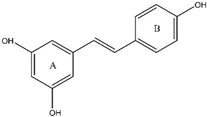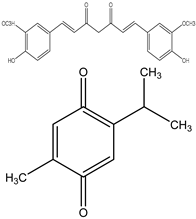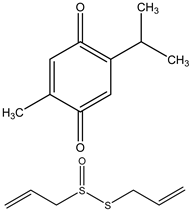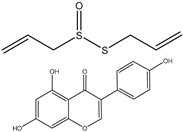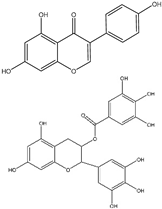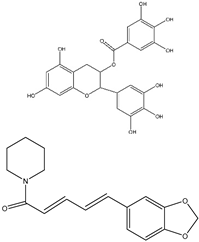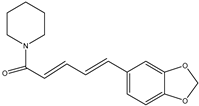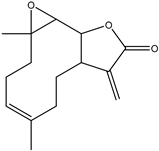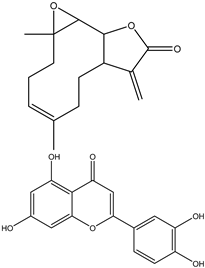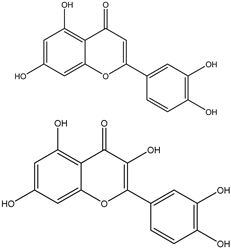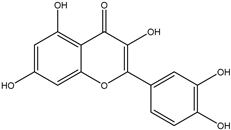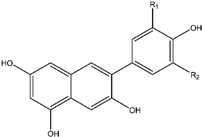Abstract
Cancer is characterized by uncontrolled cell proliferation and the dysregulation of numerous biological functions, including metabolism. Because of the potential implications of targeted therapies, the metabolic alterations seen in cancer cells, such as the Warburg effect and disruptions in lipid and amino acid metabolism, have gained attention in cancer research. In this review, we delve into recent research examining the influence of natural products on altered cancer metabolism. Natural products were selected based on their ability to target cancer’s altered metabolism. We identified the targets and explored the mechanisms of action of these natural products in influencing cellular energetics. Studies discussed in this review provide a solid ground for researchers to consider natural products in cancer treatment alone and in combination with conventional anticancer therapies.
1. Introduction
Many metabolic pathways are reprogrammed by oncogenes in most tumors, and this reprogramming is necessary for tumor initiation and essential to the tumor’s continued growth and multiplication []. Cancer cells independently alter their flux through various metabolic pathways to meet the increased demand for bioenergetic and biosynthetic resources as well as to lower oxidative stress, which, in turn, is essential for cancer cell proliferation and survival. Moreover, cancer driver mutations regulate the flux of these metabolic pathways in conjunction with the availability of nutrients in the surrounding environment. Furthermore, when metabolites build up abnormally, they can also aid in developing tumors []. In addition, compared to their nontumor counterparts, tumor cells typically metabolize glucose, lactate, pyruvate, hydroxybutyrate, acetate, glutamine, and fatty acids at significantly higher rates []. The discovery of the mitochondrial respiratory chain complex IV by Otto Warburg, who was awarded the 1931 Nobel Prize in Medicine or Physiology, is credited with helping to establish the basis of cancer metabolism []. Warburg noted that cancer tissue slices often utilize copious quantities of glucose to produce lactate, even in the presence of oxygen, in contrast to normal tissues. This phenomenon is known as aerobic glycolysis or the Warburg effect. According to Warburg, an “injury to respiration” caused by cancer cells is necessary for a differentiated cell to change into a proliferative cancer cell []. Moreover, tumor cells have been shown to have altered interactions involving various intermediates of glycolysis, the TCA cycle, the ETC, the pentose phosphate pathway, and lipid metabolism pathways, all of which have been implicated in the development of tumors [].
As the field of oncology advances, there is a growing recognition of the potential to modulate these metabolic pathways for therapeutic benefits.
According to the literature, numerous natural products are available as chemoprotective agents against common cancers that occur globally. It has long been known that natural products contain a wide variety of bioactive substances. Many of these substances have anti-inflammatory, antioxidant, and anti-proliferative qualities, which in turn make them desirable candidates for cancer biology interventions. These natural products can be found in vegetables, fruits, plant extracts, and herbs [,]. In addition, natural products can treat tumors safely and effectively. By optimizing their structure, they can also serve specific biological functions []. Moreover, by targeting the glycolytic/metabolic phenotype, natural products can inhibit the process of glycolysis and impede tumor growth and migration. Increasingly, the signaling pathways and important components involved in aerobic glycolysis are regulated by natural products. Three pathways exist for natural products to control aerobic glycolysis. Firstly, natural products influence glycolysis in tumor cells by controlling glycolytic enzymes directly. Secondly, natural products have the potential to regulate genes associated with aerobic glycolysis by modulating oncogenes such as HIF-1α, MYC, and p53, which could alter a tumor cell’s metabolic pathways. Thirdly, natural products have the ability to inhibit the glycolysis of tumor cells by acting on the PI3K/Akt/mTOR or AMPK pathways []. For instance, the polyphenol resveratrol, which is present in grapes, prevents glycolysis by triggering AMP-activated protein kinase (AMPK), which in turn prevents colon cancer from spreading and invading []. More recently, research has attempted to clarify how natural products might affect cancer cells’ altered metabolism, opening up new therapeutic research directions. As cancer is characterized by metabolic reprogramming, natural products have been identified as possible cellular metabolism modulators with implications for cancer therapy and prevention. Hence, this review will focus on recent articles so as to investigate the impact of natural products on altered metabolism in cancer.
2. Cellular and Cancer Metabolism
Cells require energy for survival, growth, and division, which is obtained through absorbing nutrients like glucose. This energy is broken down through metabolic processes such as glycolysis and OXPHOS-mediated cellular respiration. Normal cells primarily rely on OXPHOS for energy production, but cancer cells proliferate at a rate more than the angiogenesis capacity, leading to low oxygen levels. Glycolysis occurs in cancer cells even when oxygen is present, leading to increased glycolytic ATP production [,,,]. The Warburg effect of aerobic glycolysis has been identified as the leading cause of elevated glycolysis in cancer cells. However, research has shown that most cancer cells do not exhibit mitochondrial damage. However, aerobic glycolysis can occur concurrently to improve energy production for the long-term maintenance of cancer cell homeostasis [,]. Tumor cells rely on glutamine as a metabolic substrate and energy source, which impacts amino acid transport, autophagy, and metabolism [] (Figure 1). Metabolic reprogramming in cancer cells is regulated by multiple pathways, including PI3K/Akt, which enhances glucose uptake and glycolysis [,]. AMPK regulates nutrient availability, promotes tumorigenesis under metabolic stress, and activates mTORC1/2, which controls the downstream signaling of metabolism, apoptosis, protein and lipid synthesis, and cell survival [,,]. Oncogenes like c-Myc and HIF-1α are master inducers of cancer glycolysis via the direct or indirect transactivation of cancer glycolytic genes []. C-Myc expression in cancer cells promotes energy production and anabolic processes, leading to rapid proliferation without growth factor stimulation []. In addition, the main cause of increased glycolysis and lactate production during hypoxia is HIF-1α []. In normal O2 conditions, HIF-1α upregulates the genes for glycolytic enzymes, erythropoietin (EPO), glucose transporter 1 (GLUT1), and vascular endothelial growth factor (VEGF) [,]. In addition to increasing the rate of glycolysis, HIF-1α activation suppresses oxidative phosphorylation by upregulating genes like LDH-A and pyruvate dehydrogenase kinase 1 (PDK1) (Figure 1). Pyruvate’s entry into the TCA cycle is inhibited []. It has been suggested that HIF-1α inhibition could be a therapeutic approach to treat cancer because of the role of HIF-1α in aerobic glycolysis and mitochondrial function [,,,]. Figure 1 represents the main metabolic pathways.
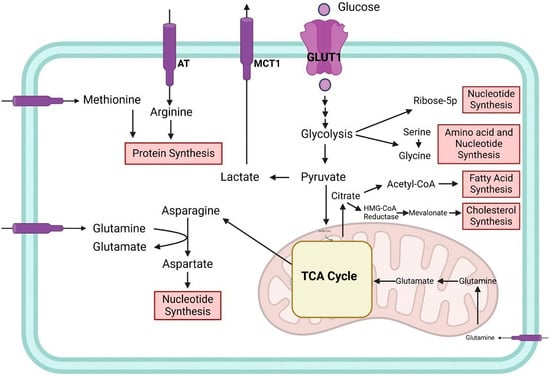
Figure 1.
The Main metabolic pathways deregulated in cancers. This figure illustrates the reprogrammed metabolic pathways found in cancer cells. It emphasizes the Warburg effect, which results in lactate production even in oxygen since glucose is primarily metabolized through glycolysis. Important intermediates that support the production of fatty acids, cholesterol, proteins, nucleotides, and acetyl-CoA include pyruvate. The other amino acids, such as aspartate and asparagine, aid in cellular growth, whereas glutamine metabolism powers the TCA cycle and nucleotide production. The diagram shows how these changes in metabolism are coordinated by cancer cells to maintain their fast growth and survival.
3. Natural Products Targeting Cancer Metabolism
3.1. Resveratrol (RV)
Resveratrol (RV) is the most compelling polyphenolic compound. It is present in a wide range of fruits and vegetables, including peanuts, grapes, and sprouts. RV was first isolated from Veratrum grandiflorum, also known as white hellebore plants []. Resveratrol’s chemical structure consists primarily of two aromatic rings linked by a methylene bridge. It occurs naturally in trans- and cis-isomeric forms. It has been noted that trans-resveratrol and its glucoside provide a variety of benefits, such as anti-tumor, cardioprotective, anti-oxidative, and anti-inflammatory qualities []. Resveratrol is a highly effective scavenger of radicals produced by cells and triggered by metals, enzymes, hydroxyls, and superoxides. It also guards against reactive oxygen species (ROS)-induced DNA damage and lipid peroxidation within cell membranes []. Preclinical research has extensively examined the potential use of resveratrol as a nutraceutical and therapeutic agent for a wide range of disorders. Cancer patients are particularly interested in using it because of the substantial risks involved with traditional therapies like chemotherapy and surgery []. The effects of resveratrol on tumor initiation, development, and progression were initially observed in 1997. Since then, numerous studies have shown its extensive prophylactic and curative benefits against a wide range of cancer types, including liver tumors, gastrointestinal tract, breast, lung, and prostate cancers. When combined with other cytostatic medications, resveratrol exhibits notable chemo-preventive effects on malignancies by targeting numerous in vitro and in vivo pathways, further highlighting its therapeutic potential [].
It is known that malignant cells are highly dependent on the glycolytic pathway to meet their energy and metabolic intermediate needs when it comes to cancer. Even under aerobic conditions, they switch from oxidative phosphorylation to glucose fermentation as their primary ATP-producing process []. These cells have a greater need for glucose than normal cells because of this metabolic shift, which produces less ATP per glucose molecule. Cancer cells frequently overexpress the glucose transporter 1 (GLUT1), a facilitative carrier to maintain a steady source of glucose [,]. Targeting glucose metabolism as a therapeutic method in cancer treatment has a biological basis in the differences in energy metabolism between normal and cancerous cells []. Inhibiting glucose transporters in neoplastic cells is a promising cancer treatment method that seeks to create an energy-deprivation condition that can enhance the effects of other anticancer medicines []. One important way resveratrol affects cancer metabolism is by interfering with signaling pathways essential for cell division and survival. As mentioned above, malignant cells supply their demand for glucose by overexpressing transporters such as GLUT1 [,]. Resveratrol has been demonstrated to inhibit the cell membrane transport by GLUT1 via the Akt/mTOR-dependent signaling pathway []. The inhibition of the Akt/mTOR-dependent signaling pathway reduces anabolic pathways, decreases glucose uptake, and produces less lactate in a variety of cancer cell lines via down-regulating PKM2 expression []. Kueck et al.’s study, which evaluated the impact of RV on the viability and glucose uptake of five human ovarian cancer cell lines, revealed that treatments lasting up to eight hours could decrease cell viability, lactate production, glucose uptake, Akt, and mammalian target of rapamycin (mTOR) signaling in a manner that was dependent on time and dose [,]. The authors concluded that autophagy-mediated cell death was triggered in ovarian cancer cells by the energy deprivation state generated by RV [].
The metabolism of cancer cells requires the high absorption of glucose; this process is tightly controlled and involves several components, including growth factors []. Within healthy cells, intracellular glucose is phosphorylated by hexokinase to produce glucose-6-phosphate, which is then transformed into 3-carbon pyruvate, producing ATP and NADH. Rather than fermenting glucose, healthy cells use oxidative phosphorylation to efficiently synthesize ATP and CO2 when oxygen is present (a process known as aerobic glycolysis) []. On the other hand, tumor cells rely heavily on the fermentation, or breakdown, of glucose []. Regardless of oxygen supply, most cancer cells display an altered metabolism defined by increased glycolysis and lactate generation; this is called the Warburg effect []. Resveratrol has been shown to modify the Warburg effect, as shown in Figure 2 [,].
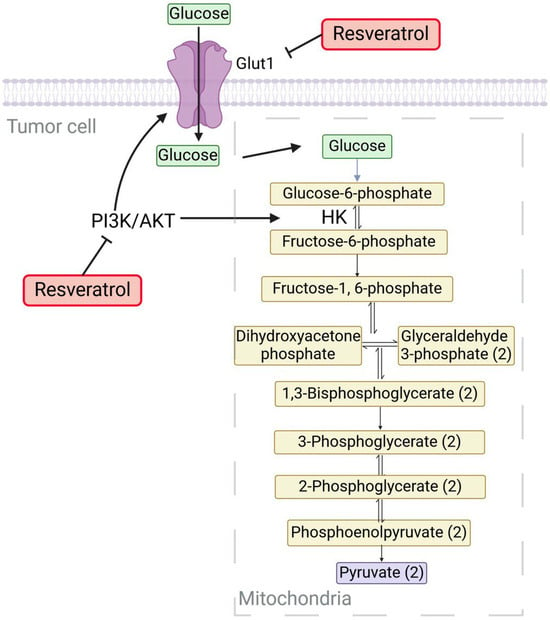
Figure 2.
Resveratrol appears to inhibit necessary glycolysis-related enzymes, causing a change in cellular energy metabolism to oxidative phosphorylation and encouraging a more normal metabolic state. This metabolic reprogramming may prevent cancer cells from proliferating quickly by limiting their access to energy.
According to the authors of [], who demonstrated that the tumor cells are weakened, effective anti-tumor therapy is supported by a low pH tumor microenvironment, which is linked to several aspects such as reduced vascularization, food deprivation, and hypoxia in the setting of the Warburg effect.
Tumor cells need a steady and consistent supply of nucleotides for DNA synthesis and energy to fuel their hyperactive proliferation. The pentose phosphate pathway (PPP) provides these essential commodities. Remarkably, many PPP enzymes exhibit severe dysregulation within malignancies. The initial step in the PPP is catalyzed by glucose-6-phosphate-dehydrogenase (G6PDH), an essential enzyme that controls the rate at which tumor cells grow. Elevated G6PDH expression and PPP activity are common in malignant tumors [,,,]. Since G6PDH knockdown dramatically decreases cell growth, targeting G6PDH with targeted inhibition may be a helpful therapy option for glycolytic malignancies []. For survival, tumor cells transition to aerobic glycolysis. Consequently, the primary enzyme for identifying the glycolytic phenotype of tumor cells is lactate dehydrogenase (LDH), which catalyzes the conversion of pyruvate to lactate. As a result, LDH may be used as a therapeutic target. Indeed, the advancement of lymphomas and pancreatic cancer xenografts is inhibited by LDH inhibition []. There are more glycolytic intermediates available for biosynthetic pathways, including PPP, which speeds up the growth of tumors and the synthesis of macromolecules like ribose-5-phosphate (R5P) []. R5P is a crucial pathway of pentose phosphate intermediate that acts as a precursor to the synthesis of macromolecules []. The procedures that turn food carbon into FAs are part of lipid synthesis. Glycerol-3-phosphate transforms FAs into diacylglycerides and TAGs, which create the glycerol backbones of the lipids [,]. FAs are esterified to phospholipids (PLs) in cancer cells to facilitate membrane lipid production and encourage cell division []. Research has demonstrated that apoptosis is induced when FASN is blocked in cancer cells, and cell growth arrest occurs [,]. RV dramatically decreased lipid production in many cancer cell lines by downregulating FASN [,]. Several genes related to FA and cholesterol production are induced to express themselves through the phosphoinositide-3-kinase/Akt/mammalian target of rapamycin (PI3K/Akt/mTOR) pathway [,]. Sterols, which are lipids other than cholesterol and cholesteryl-esters, are also essential for the operation of membranes [,]. The structural foundation for the production of steroid hormones, including progesterone and estrogen, is provided by cholesterol [,,]. The production of FA and cholesterol involves a class of proteins called sterol regulatory element-binding proteins (SREBPs) []. SREBPs, mediated by 3-hydroxy-3-methyl glutaryl coenzyme A reductase (HMGCR), may cause abnormally high cholesterol levels []. RV blocked the mevalonate pathway in rat theca-interstitial cells, lowered HMGCR expression and activity, and decreased cholesterol production []. Additionally, AMP-regulated protein kinase (AMPK) targets SREBPs []. RV action is shown in multiple mechanisms by Professor Ido’s group. Initially, AMPK was activated by RV-induced SIRT1 activation []. They further postulated that the unpredictability of this cascade could cause inconsistent RV effects. They discovered that RV’s action as a SIRT1 activator might come from an integrated SIRT1-liver kinase B1 (LKB1)–AMPK impact in addition to SIRT1 activation. Thus, RV activates SIRT1 by directly binding to SIRT1 and boosting nicotinamide adenine dinucleotide (NAD)+ levels by upregulating the salvage pathway through nicotinamide phosphoribosyl transferase (NAMPT) activation, an effect mediated by AMPK. In addition to encouraging the deacetylation of a select few SIRT1 substrate proteins (such as PGC-1α, peroxisome proliferator-activated receptor gamma coactivator 1-alpha), it also stimulates other sirtuins besides SIRT1. If cellular energy generation is already compromised in the course of cancer treatment, RV may expedite cell death []. High doses of RV (4 g/kg body weight/day) have been demonstrated to activate AMPK in a way that is SIRT1-independent, indicating that dosage is a crucial component of RV functionality. Consequently, it is possible that RV-induced SIRT1 activation contributes to AMPK activation in vivo and in vitro []. Sirtuins are NAD-dependent enzymes that are highly conserved. The mammalian sirtuin family impacts numerous cellular functions, such as DNA repair, lipid and glucose metabolism, and carcinogenesis []. SREBP1, a hepatic transcription factor for lipogenesis and cholesterol production, is deacetylated and destabilized by SIRT1 by focusing on the genes involved in cholesterol production; SREBP2 regulates cholesterol homeostasis [,]. Maintaining cholesterol homeostasis involves liver-X-receptor (LXR) proteins, which sense cholesterol. By inducing the expression of the ATP-binding cassette transporter A1, LXRs improve the reverse transport of cholesterol from peripheral tissues (ABCA1). High-density lipoproteins are formed when these transport proteins transfer cholesterol to apolipoprotein AI. Lipoproteins are soluble lipid–protein complexes created when apolipoproteins bind with lipids. The three main lipids that circulate in plasma are cholesterol, TAGs, and PLs [].
3.2. Curcumin (CUR)
Curcumin ((1E,6E)-1,7-bis(4-hydroxy-3-methoxyphenyl)-1,6-heptadiene-3,5-dione) is isolated from the dried root of Curcuma longa, a member of the ginger family, Zingeberaceae []. Approximately 80% curcumin, 18% demethoxycurcumin, and 2% bis-demethoxycurcumin are present in commercial-grade turmeric. It is fully soluble in ethanol or dimethyl sulfoxide but only partially soluble in water. Steam distillation has been used to separate essential oils from the turmeric root, including a-phellandrene (1%), sabinene (0.6%), cineol (1%), borneol (0.5%), zingiberene (25%), and sesquiterpenes (53%) []. Most recently, studies have shown that curcumin is a powerful anti-inflammatory and antioxidant substance with a variety of medicinal uses []. Curcumin regulates cytokines, different kinase proteins, growth factors, and their receptors, all of which are involved in the growth and advancement of the cell cycle []. Traditional Indian and Chinese medicine both employed curcumin as a therapy for various illnesses.
Curcumin has been used for medical purposes since the Unani and Vedic eras. In addition, it obstructs the transmission mechanisms and molecular targets connected to the start and development of different malignancies. Curcumin has been proven to be an effective treatment for several types of cancer, as shown in Figure 3.
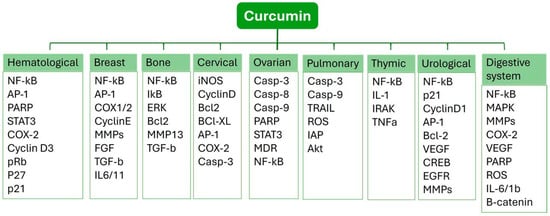
Figure 3.
Illustration of multiple molecular targets of curcumin in various cancers.
It has been shown that by independently blocking the PI3K/Akt/mTOR pathway, plumbagin and curcumin both have anticancer action. Their combined impact on this route is still unknown. A growing body of research indicates that the combination of medications shows better efficacy in treating cancer [,]. Curcumin has been shown to increase radiation-induced apoptosis in human Burkitt’s lymphoma cells by blocking the PI3K/Akt pathway and its downstream NF-κB protein expression [].
3.3. Thymoquinone (TQ)
Thymoquinone, an active component obtained from Nigella sativa seeds, is used extensively in treating various illnesses due to its documented antibacterial, antioxidant, anticancer, and anti-inflammatory properties. In various cancer types, such as bladder, colon, pancreatic, neuroblastoma, osteosarcoma, myeloblastic leukemia, and acute lymphoblastic leukemia, thymoquinone demonstrates cytotoxic effects by preventing cell proliferation and triggering cell apoptosis (Figure 4).
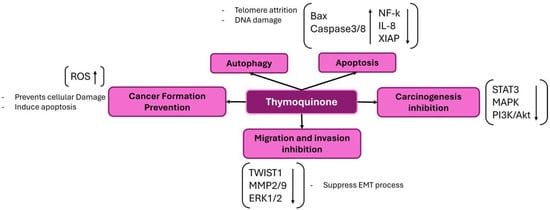
Figure 4.
The figure demonstrates the several ways that thymoquinone works to prevent cancer. Thymoquinone inhibits cancer development by raising reactive oxygen species (ROS) levels, which trigger apoptosis and prevent cellular damage. Furthermore, it inhibits cancer development by modifying vital signaling pathways like STAT3, MAPK, and PI3K/Akt. Furthermore, it triggers apoptosis by controlling proteins linked to apoptosis, such as Bcl-2, Bax, and Caspase-3/8. Thymoquinone also suppresses the migration and invasion of tumor cells by downregulating EMT-related factors such as MMP2/9, ERK1/2, and TWIST1.
Thymoquinone altered the Bax, Bcl2, and cytochrome c protein levels and caused mitochondrial dysfunction in T24 and 253J bladder cancer cells. The apoptosis-promoting effect of thymoquinone may be partially reversed by pretreatment with the pan-caspase inhibitor Z-VADfmk. This effect is achieved by promoting the expression of the antiapoptotic protein Bcl2, inhibiting the translocation of Bax from the cytoplasm to mitochondria, and preventing the release of cytochrome c []. In the irinotecan-resistant (CPT-11-R) LoVo colon cancer cell line, thymoquinone was also discovered to stimulate autophagic cell death and trigger mitochondrial outer membrane permeability []. Thymoquinone, betulinic acid, and gemcitabine pretreatments, together with gemcitabine, effectively inhibited the growth of cancer cells in vitro by downregulating the expression of PKM2, a promising part of cellular metabolism []. Thymoquinone caused mitochondrial apoptosis in acute lymphocyte leukemic CEM-ss cells by activating caspases 3 and 8 and producing cellular ROS [].
3.4. Allicin
Poor Man’s Treacle is a member of the Amaryllidaceae family, which includes garlic (Allium sativum L.). Garlic bulbs are composed of 65% water, 28% carbohydrates, 2% organosulfur compounds, 2% proteins (mostly allinase), 1.2% amino acids, and 1.5% fiber [].
Throughout history, many civilizations have used garlic in cooking, but its most widespread application has been in Mediterranean cuisine, specifically in the Middle East and Asia. It is believed to have been planted in the Middle East around 5000 years ago and is among the oldest plants still in cultivation, along with other growing crops. Moreover, garlic has been used historically and currently as a medicinal for many years [].
Prevention of damage to DNA and anti-inflammatory properties: finding natural substances that can stop or limit DNA damage is essential because it is a necessary step at the beginning of the entire carcinogenic process. Allicin can increase indirect DNA protection (antioxidant activity and oxidizing enzyme regulation), direct DNA protection, and immunity regulation.
Reactive oxygen species (ROS) and reactive nitrogen species (RNS) are highly reactive chemicals. Because they take part in many signaling mechanisms, cellular metabolism frequently produces ROS and RNS. Oxidative and nitrosative stress happens when the quantity of ROS and RNS exceeds the antioxidant systems’ capacity. Subsequently, ROS and RNS impair cellular functionality by causing damage to cell components, including DNA. Because of this, squelching free radicals is a tactic to stop the formation of tumors, as they are involved in cancer development [].
Few studies were conducted to verify the in vivo anticancer potential of allicin. Allicin was tested on a variety of tumor mouse models, including cholangiocarcinoma [], colon cancer [], and lymphoma []. These studies showed the potential of allicin to inhibit tumor growth in vivo. Regarding the in vitro tests, the precise mechanism of action remains to be determined. Allicin was able to modify STAT3 and decrease the tumor burden in colorectal tumor models [] and cholangiocarcinoma []. Apoptosis is a sign of allicin’s antagonistic action on tumor growth in mice harboring lymphomas []. Similarly, intratumor injection of a low dose of allicin (500 µg/mouse every other day for a sequential 14 days) inhibited tumor growth in mice xenografted with hepatocellular carcinoma cells, causing both intrinsic and extrinsic apoptosis, more so than the positive control DOX (20 µg/mouse), partially elevating Bax and FASL mRNA []. The combination of 10 µg of allicin and 20 µg of DOX produced the greatest results for both tumor development and apoptotic marker expression []. This indicates that allicin can be utilized as an adjuvant chemical. Figure 5 shows various mechanisms that allicin utilizes to fight cancer.
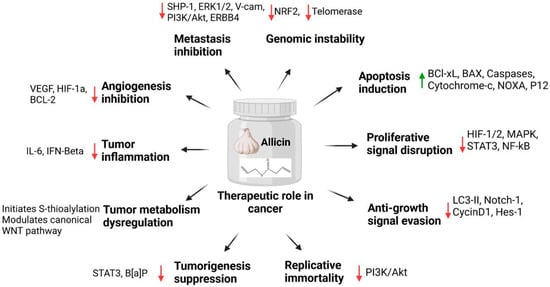
Figure 5.
The figure shows that allicin can stimulate apoptosis and interfere with proliferative signaling pathways such as HIF-1/2, MAPK, and NF-κB while suppressing metastasis, genomic instability, and angiogenesis. Additionally, pathways, including STAT3 and PI3K/Akt, suppress carcinogenesis, modify tumor metabolism, and lower tumor inflammation. Allicin also inhibits replicative immortality and avoids anti-growth signals, which adds to its overall anticancer effect.
3.5. Genistein
Genistein is a small biologically active isoflavonoid found in high concentrations in soybeans. It is a natural phytoestrogen that is associated with a variety of beneficial activities such as antioxidant, anti-inflammatory, antibacterial, antiviral, cholesterol regulation, osteoporosis prevention, and anticancer effect [,]. The mechanisms of genistein to inhibit cancer are comprehensive and involve a considerable number of molecular pathways [].
Genistein has a structural similarity with natural estrogen, allowing it to block estrogen’s hormonal activity, which makes it a perfect candidate to manage estrogen-dependent cancers like breast cancer, ovarian cancer, and endometrial (uterine) cancer []; likewise, decreasing the symptoms of postmenopausal []. Genistein has been proven preclinically effective against various types of human cancers such as breast, lung, liver, prostate, pancreatic, skin, cervical, bone, uterine, colon, kidney, bladder, neuroblastoma, gastric, esophageal, pituitary, salivary gland, testicular, and ovarian cancers [].
Genistein exhibits its activity through two approaches: firstly, the chemoprevention by inhibiting the formation of COX-2 and oxidative stress; secondly, by targeting carcinogenesis possible pathways and interfering with their mechanism via suppressing cancer cell proliferation, metastasis, invasion, tumor angiogenesis, regulation of epigenetic, activation of survival pathway, matrix metalloproteinase (MMP), and vascular endothelial growth factor (VEGF) [].
One way is by inhibiting cancer metastasis with dual activity exerting effects on the initial steps of primary tumor growth and the later steps of the metastatic cascade []. It works by inhibiting the phosphorylation of Focal Adhesion Kinase (FAK) that is responsible for activating the signaling pathway to control cell migration [].
Additionally, genistein can inhibit the vascular endothelial growth factor (VEGF) by lowering the activity of cyclooxygenase-2 (COX-2) responsible, as well as matrix metalloproteinase 9 (MMP-9) expression, which is highly expressed in cancer cells, either by activating the AMPK pathway or by deactivating the PIP3 pathway [].
Genistein is an anti-tumoricidal molecule in different types of cancer (Figure 6); it can induce apoptosis by mediating various signaling cascades, including caspases through extrinsic and intrinsic mitochondrial pathways [].
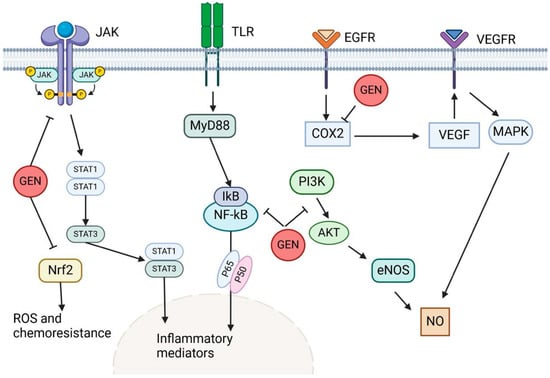
Figure 6.
This figure illustrates how genistein (GEN) targets multiple signaling pathways in cancer metabolism and therapy resistance. By blocking the JAK/STAT pathway, GEN inhibits the generation of ROS and chemoresistance. Additionally, it suppresses the TLR/MyD88/NF-κB pathway, reducing inflammatory mediators connected to tumor development. Furthermore, GEN suppresses COX-2, which impacts the PI3K/Akt pathway and lowers angiogenesis and cell survival. GEN, the last target, inhibits VEGF-driven angiogenesis by targeting the VEGFR/MAPK pathway.
Another mechanism for apoptosis induction is simply by interfering with Akt (also known as serine-threonine protein kinase B), which is needed for the reaming of cell survival. Genistein inhibits Akt/NF-κB pathways, inducing apoptosis as seen in breast and prostate cancer [].
Genistein downregulates hypoxia-inducible factor-1α (HIF-1α), therefore inactivating glucose transporter 1 (GLUT1) or/and hexokinase 2 (HK2), which in turn suppresses aerobic glycolysis and mediates apoptosis [].
Genistein has proven its ability to restrain the formation of new blood vessels by inhibiting the expression of vascular endothelial growth factor (VEGF), which is a key regulator of angiogenesis. It also downregulates platelet-derived growth factor, urokinase plasminogen activator, matrix metalloprotease-2 (MMP-2), and MMP-9 expression, as seen in bladder cancer and oral squamous cell carcinoma []. Another way to explain the effects of genistein anticancer activity on cancer cells is by deregulating the cell cycle to ensure the regulation of cell growth and cell cycle progression in cancer cells, modulating the expression of cell cycle-regulatory proteins to arrest the cycle in different phases. Genistein has been found to arrest the cell cycle progression at the G2-M phase in human gastric carcinoma cells as well as in galectin-3-transfected human breast epithelial cell []. Although there is significant evidence about the potential preventive and therapeutic effects against cancer, a significant consideration regarding its safety at high doses must be considered [].
4. Epigallocatechin Gallate
Globally, millions of individuals consume green tea daily, and its polyphenol compounds have been widely studied for their anticancer properties. Among these, epigallocatechin gallate (EGCG), a major catechin in green tea, has shown the most potent antiproliferative effects. In a comparative study of ten polyphenols, including caffeic acid (CA), gallic acid (GA), catechin (C), epicatechin (EC), and their derivatives, EGCG exhibited a solid ability to induce apoptosis and cause G1 phase cell cycle arrest in cancer cells [].
While GA also demonstrated some antiproliferative effects, the esterification of C and EC with GA to form CG and ECG (epicatechin gallate) significantly enhanced these properties [,].
A comparable correlation was discovered between EGCG and EGC. The gallic acid group significantly increased the anticancer properties of catechins. This characteristic might be used to synthesize flavonoid derivatives to create brand-new anticancer drugs [].
The synergistic effects of EGCG with other compounds, such as ginseng derivatives, further underscore its role in cancer chemoprevention. For instance, combining EGCG with panaxadiol (PD), a purified component of ginseng, has been shown to significantly inhibit colon cancer cell proliferation [,]. Previous studies observed that ROS levels were decreased by combining therapy with ginseng and antioxidants. ROS accumulated in ginseng-treated colorectal cancer cells activated a cellular signaling defense system. The results of a pilot investigation indicated that epicatechin, but not catechin, the two naturally occurring antioxidants in green tea, increased the anticancer activity of panaxadiol (PD), a purified ginseng component. A further study found that using PD combined with epigallocatechin gallate (EGCG), a key catechin found in green tea, synergistically affected colon cancer cells [].
The most prevalent and potent antioxidant in green tea for the chemoprevention of cancer is EGCG. Green tea may work well with anticancer medications to prevent cancer by increasing their inhibitory effects on colon cancer cell proliferation, as demonstrated by an earlier study where EGCG amplified the effects of ginseng components in this regard. Despite these findings, a comprehensive comparison of the distinct effects of various tea polyphenols on colon cancer prevention remains to be conducted. Figure 7 illustrates the proposed mechanisms by which EGCG may inhibit key cancer hallmarks.

Figure 7.
The figure depicts how epigallocatechin gallate (EGCG) suppresses reactive oxygen species (ROS) and its downstream effects on NF-κB signaling. EGCG inhibits ROS, which in turn reduces NF-κB activation. This inhibition decreases COX-2, IL-1β, and MMP9 expression, reducing metastasis, invasion, and inflammation. Additionally, the suppression of TNF-α by NF-κB further diminishes inflammatory responses.
5. Piperine
Piperine (1-Piperoylpiperidine) is an alkaloid component found in fruits, black pepper (Piper nigrum), or long pepper (Piper longum). It is a daily consumed dietary phytochemical all around the world due to the popularity of the black pepper as a spice; it is the reason for its distinguished biting taste. Plus, it is responsible for the range of benefits of pepper because of its anti-inflammatory, immunosuppressive, and antibiotic characteristics which makes it a great candidate for many therapeutic applications [,].
It was tested on different types of cancer cells, and it showed great therapeutic potential for breast cancer, ovarian cancer, gastric cancer, glioma cancer, lung cancer, oral squamous cell carcinoma, prostate cancer, colorectal cancer, cervical cancer, leukemia [], melanoma, fibrosarcoma, and osteosarcoma [].
Piperine has a diverse mechanism of action, which gives it two unique properties as a chemopreventive agent: it can block the initiation of tumors and suppress the transformation of initiated cells into neoplastic cells [].
In addition to its prevention action, it can potentially be considered a therapeutic agent that can target and tackle cancer cells without harming normal cells, overcoming the biggest obstacle in classical pharmacological treatments of cancer [].
Piperine interferes with the abnormal mechanisms of the cancer cells in many ways. One approach is to induce the death of cells. Piperine can induce various cell death types, including apoptosis and autophagy, as seen in breast and prostate cancer. Piperine can trigger the intrinsic apoptotic pathway by releasing mitochondrial cytochrome c, activating caspase-3 and -9, cleaving poly-ADP ribose polymerase (PARP), and inactivating p38/MAPK (mitogen-activated protein kinase) and NH2-terminal kinase (JNK). Moreover, it can activate extrinsic pathways of apoptosis by activating the pro-apoptotic proteins, which lead to upregulation of C/EBP homologous protein (CHOP), glucose-regulated protein 78 (GRP78), inositol requiring enzyme-1(IRE1a), and JNK as observed in murine and human breast cancer cells [].
Piperine increases phosphatidylethanolamine conjugate 3II (LC3II/ATG8), a signaling pathway that interacts with mammalian target of rapamycin (mTOR) complexes 1 and 2. These complexes are involved in cell survival, leading to their inhibition and, in turn, promoting autophagy, as seen in colon carcinoma [].
Ferroptosis is a type of cell death that happens because of the excess accumulation of iron and lipid peroxides due to an imbalance in reactive oxygen species (ROS). Piperine has the potential to increase ROS as well as intracellular calcium levels, which can activate the Fenton reaction and lead to cell death. On the other hand, piperine activates anoikis, which is a programmed cell death that happens due to the loss of attachment to the extracellular matrix [].
The cell cycle is a series of events that take place inside the cell in order to divide into 2 separated identical daughter cells. In cancer cells, the cell cycle is highly disrupted and irregular. The key regulators of the cell cycle include cyclin-dependent kinases (CDKs), cyclins, and CDK inhibitors (CKIs). Piperine interferes with the cell cycle by affecting various protein regulators and checkpoints, including downregulating cyclin D1 and the induction of p21, a CDK inhibitor [].
Cancer cells usually have high levels of ROS. Multiple studies reported piperine’s ability to target ROS in two different ways depending on the administered dose. Piperine can function as a defense mechanism against ROS when given in a low dose in mouse and rat models. On the other hand, administering piperine in high doses will function as a pro-oxidant by elevating the levels of ROS, resulting in cell apoptosis []. Figure 8 shows the different anticancer mechanisms that piperine utilizes.
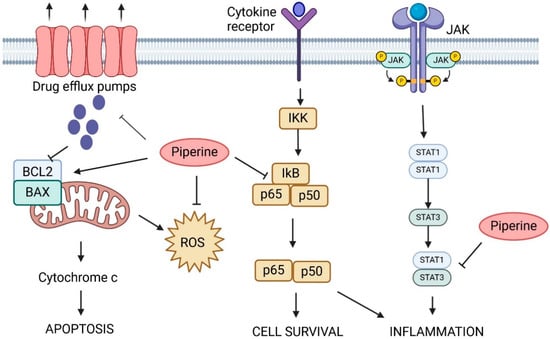
Figure 8.
In this figure, piperine inhibits ROS, leading to reduced NF-κB activation, which diminishes cell survival and inflammation. It also disrupts STAT3 signaling, further reducing inflammation. By affecting the BCL2/BAX balance, Piperine promotes cytochrome c release and apoptosis. Additionally, piperine’s influence on drug efflux pumps suggests its potential to enhance chemotherapeutic efficacy.
Cancer cells have a unique phenomenon that helps stabilize them and improve their chances of growth and survival; they are capable of forming new blood vessels by exciting vessels, which is known as angiogenesis or neoangiogenesis. Piperine can inhibit this crucial mechanism by inhibiting proliferation and the G1/S transition of human umbilical vein endothelial cells (HUVECs), inhibiting collagen-induced blood vessel outgrowth, downregulation of the pro-angiogenetic protein kinase B (Akt) signaling cascade, and decreasing the expression of vascular endothelial growth factor (VEGF) []. In addition, piperine has demonstrated the ability to induce the differentiation of osteoblasts by affecting the expression of osteogenic marker genes through AMPK phosphorylation and inhibiting the Wnt/beta-catenin signaling pathway in breast cancer [].
Piperine is a bioavailability enhancer for several chemotherapeutic agents, such as resveratrol and curcumin. By affecting multiple pathways, piperine has an inhibitory effect on the enzymes responsible for metabolizing drugs like cytochrome P450 3A4, which alone metabolizes more than fifty percent of the marketed drugs.
Piperine-based treatments may become a standard part of the management of cancer, but further studies are needed to understand the specific molecular targets and pathways influenced by piperine, as well as an assessment of its efficacy and safety [].
6. Emodin
Emodin, a naturally occurring anthraquinone derivative that is a tyrosine kinase inhibitor and is present in the rhizomes and roots of many different plants [], is widely used in traditional Chinese medicine as a laxative (Figure 7).
Emodin has demonstrated potential in pre-clinical settings as a natural anticancer medication for the management of multiple cancer types, including breast, pancreatic, colon, stomach, liver, gallbladder, and lung malignancies [,,,]. Research has indicated that emodin suppresses the growth of various cancer cell types and inhibits pathways that lead to inflammation, proliferation, angiogenesis, tumorigenesis, invasion, and metastasis, as well as promotes mitochondrial-mediated apoptosis.
The anticancer effects of emodin were examined in A2780 and SK-OV-3 epithelial ovarian cancer cells []. Emodin was administered to both cancer cell lines, and the incubation period was one to three days. The antiproliferative effects of emodin therapy were dose- and time-dependent. Trans-well migration and invasion experiments further demonstrated the anti-invasive and anti-metastatic properties. This investigation also demonstrated the compound’s effects on the epithelial-mesenchymal transition. Protein analysis revealed that mesenchymal indicators like vimentin and N-cadherin were downregulated dose-dependent. In contrast, epithelial markers like E-cadherin and claudin were elevated []. Additionally, it was proven that the expression levels of Slug (a transcription factor) were also decreased with emodin therapy. Cells were transfected with siRNA to silence the essential proteins for Slug and β1integrin-linked kinase (ILK) to elucidate the mechanism of action. The findings showed that emodin inhibited cancer cells’ epithelial-mesenchymal transition by blocking the ILK/GSK-3β/Slug signaling [].
SiHa, CaSki, and HaCaT cell lines showed a marked reduction in cell viability following treatment with emodin in conjunction with photodynamic therapy. Increased reactive oxygen species (ROS) generation, caspase-3 activity, and autophagic vacuole fluorescence intensity were seen in conjunction with these decreases. This indicates that apoptosis and autophagy caused cell death in cervical cancer cells due to elevated ROS generation []. MCF-7 human breast cancer cells were used to study emodin’s anticancer properties. The findings demonstrated that emodin could impede cell division and elevate the apoptosis rate depending on both time and dosage. According to a molecular docking study, emodin can be fixed into the ATP-binding pocket of the aryl hydrocarbon receptor (AhR) protein. Further investigation revealed that emodin can function as an AhR agonist, raising the levels of both the protein and CYP1A1, its downstream target gene [].
These outcomes were validated with an AhR inhibitor (CH223191), showing a rise in the cell survival rate. Wang et al. conducted a study wherein they found that emodin had anticancer effects on various kidney cancer cells, including 786-0, ACHN, CAKI, and OS-RC-2. However, they had no harmful effects on HK-2 noncancerous cells. The mechanism of action was mediated by necroptosis rather than the stimulation of apoptosis. Therefore, in a manner linked to increased ROS and the consequent activation of the JNK pathway, necroptosis-related proteins such as receptor-interacting protein kinase-1 (RIP1) and mixed lineage kinase domain-like pseudo kinase (MLKL) were dramatically raised following emodin therapy [].
Breast cancer cells’ and macrophages’ TGF-β1 production was inhibited by emodin, which also lessened the EMT and CSC development of breast cancer cells generated by TGF-β1 or macrophages. By lowering tumor-promoting macrophages and inhibiting EMT and CSC development in the primary tumors, short-term emodin treatment prior to surgery prevented breast cancer post-surgery metastatic recurrence in the lungs. Emodin blocked TGF-β1 signaling pathways in breast cancer cells, both canonical and noncanonical, and decreased transcription factors essential for EMT and CSC, according to mechanistic investigations [].
Studies using human hepatocellular carcinoma HepaRG cells demonstrated the anticancer properties of emodin. Compared with untreated cells, emodin-induced cell cycle arrest at the S and G2/M phases and decreased cell viability in a dose/time-dependent manner. Emodin caused apoptosis in these cells and expanded the numbers of cells in both the early and late phases of apoptosis, as demonstrated by the annexin V/PI staining study []. The mechanism of action was associated with an increase in pro-apoptotic Bax expression and a decrease in anti-apoptotic Bcl-2 expression. Furthermore, in contrast to the vehicle-treated group, emodin administration dramatically increased the cleaved caspase-3, -9, and PARP expression levels. These results suggested that emodin may use the mitochondrial caspase-dependent route to cause apoptosis in hepatocellular cancer cells []. Another study also examined how emodin affected Caco-2 human colon cancer cells over the course of 24 h. Emodin suppressed cell growth (IC50) by 50% at 30 μM, resulting in a dose-dependent decrease in cell viability. Furthermore, treatment with emodin resulted in cell cycle arrest at the G2/M phase and a markedly increased proportion of cells in the early and late apoptotic stages. Furthermore, emodin was found to induce apoptosis through the mitochondrial route based on its impact on the levels of Bax/Bcl-2 protein expression and mitochondrial membrane potential. Additionally, emodin decreased the phosphorylated forms of essential proteins involved in the PI3/Akt signaling pathway, which is linked to the development of cancer and tumorigenesis. These findings raise the possibility of using emodin as an anticancer medication []. Emodin inhibits VEGFR2/PI3K/Akt signaling, which stops the human colon cancer cell line HCT116 from migrating, adhering, and multiplying [].
Researchers examined emodin’s anticancer efficacy using animal models and the hepatocellular carcinoma cell line SMMC-7721. In the control group, emodin administration decreased SMMC-7721 cell proliferation in a dose and duration-dependent manner. Using the same cell line, flow cytometric analysis showed a significant correlation between the ratio of apoptotic cells and the rise in emodin concentration. The overall expression of ERK, p38, and JNK was not affected by emodin; however, the level of p-JNK was decreased, and the phosphorylated forms of ERK and p38 were markedly increased in a time-dependent manner [].
Furthermore, there was a drop in p-Akt levels but not in total Akt expression. Moreover, the emodin-treated SMMC-7721 cells exhibited a substantial upregulation of cleaved caspase-3 and -9 expression levels. After subcutaneously injecting 5 × 106 SMMC-7721 cells into BALB/c-nu nude mice, the ameliorative impact of emodin was analyzed. Treatment with emodin exhibited a dose-dependent inhibition of tumor growth in mice, with no discernible impact on the mice’s overall body weight. Emodin’s antiproliferative action in animal models was corroborated by a considerable decrease in the proliferating cell nuclear antigen (PCNA) protein and Ki-67 levels. In summary, this study showed that emodin may have ameliorative effects when used to treat hepatocellular cancer (Figure 9) [].
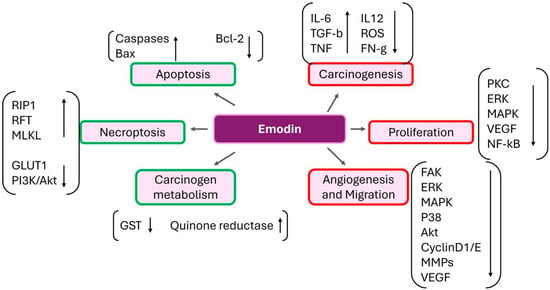
Figure 9.
The figure illustrates how cancer processes are modulated by emodin. It promotes apoptosis and necroptosis while inhibiting proliferation, angiogenesis, and migration. It also enhances carcinogen metabolism and suppresses carcinogenesis by regulating critical pathways like FAK, ERK, MAPK, VEGF, and inflammatory cytokines.
A different investigation documented Emodin’s efficacy in treating human non-small lung cancer cell lines A549 and H1299. Emodin administration led to a dose-dependent decrease in the rate of proliferation and an increase in the rate of apoptosis, which is in line with the previously reported outcomes. Furthermore, tribbles homolog 3 (TRIB3)’s function was ascertained through small interfering RNA (siRNA) knockdown. The acquired data suggested that a decrease in the rate of apoptotic cells resulted from the silence of this gene. The apoptotic effect of emodin was dramatically reduced due to the suppression of NF-κB activation resulting from both TRIB3 gene silencing and 4-phenylbutyrate (4-PBA)-induced ER stress []. Consequently, all these results pointed to a mechanism by which ER stress and the activation of the TRIB3/NF-κB pathway in lung cancer cells drive the apoptotic effects of emodin. During the same investigation, growth factor-reduced matrigel and A549 cancer cells were administered subcutaneously into BALB/c nu/nu nude mice. When emodin treatment was combined with 4-PBA exposure, the effect was attenuated, but the tumor growth was still significantly reduced compared to the control groups [].
Human cells T24 and T5637 were used by Ma et al. to test the action of emodin. They found that emodin inhibits the expression of Notch1, which slows the growth of bladder cancer [].
7. Parthenolide
Sesquiterpene lactone (SL) parthenolide (PTL) was first extracted from feverfew (Tanacetum parthenium) shoots and has demonstrated strong anti-inflammatory and anticancer properties. Clinical trials are currently testing it for cancer []. Parthenolide’s structure-activity relationship (SAR) research led to the derivatization of dimethylamino-parthenolide (DMAPT), an orally bioavailable analog, by revealing important chemical features needed for biological activities and epigenetic pathways []. Parthenolide is the first tiny chemical discovered to be selective against cancer stem cells (CSC). It accomplishes this by focusing on particular signaling pathways and eradicating cancer from its roots []. The anticancer property of PTL was first validated in 1973 []. Furthermore, its patent application for tumor suppression was approved in 2005 []. Numerous studies have confirmed PTL’s antitumor potential in vitro and in vivo in various cancer types. This is primarily due to its cytotoxicity to the majority of cancer cells and its ability to specifically target cancer stem cells (CSCs), a subpopulation that is currently thought to be responsible for tumor relapse and chemotherapy resistance [,,,,,,,]. Subsequent investigations uncovered several direct PTL targets, including p65, IκB kinase (IKK), focal adhesion kinase 1 (FAK1), and others, which have an indirect impact on signaling pathways that are responsible for the antitumor properties of PTL. These pathways account for redox imbalance, cell cycle arrest, induction of apoptosis, suppression of metastasis, and epigenetic regulation [,,,].
PTL has been used in combination with several anticancer drugs, including inducers of reactive oxygen species (ROS), tubulin-directed medicines, anthracyclines, antimetabolites, histone deacetylase inhibitors, and mTOR inhibitors, as reviewed by Malgorzata et al. [].
PTL had antiproliferative activity in practically all tests, with half-maximal inhibitory concentrations (IC50) ranging from 2.5 to 25 μM for most tumor cells, highlighting its cytotoxicity to many cancer cells []. Several studies have shown that PTL therapy can cause intrinsic or extrinsic apoptosis in tumor cells by activating the p53 signaling route, regulating the Bcl-2 family members, blocking the activities of the NF-κB signaling pathways, and producing reactive oxygen species [].
According to research by Berdan et al., parthenolide covalently alters FAK1’s cysteine 427, which inhibits FAK1-dependent signaling pathways and reduces the motility, survival, and proliferation of breast cancer cells [].
Further supporting its role as a multifunctional agent, PTL was identified as a novel inhibitor of USP7 based on the following evidence: (a) PTL inhibited USP7-mediated hydrolysis of Ub-AMC/Ub-Rho110 and di-Ub; (b) PTL competed with the binding of the Ub-VME/Ub-PA probe to USP7; and (c) CETSA, SPR, and MS analyses revealed that PTL directly interacted with USP7 [].
In another study focusing on esophageal squamous cell carcinoma (ESCC), PTL inhibited both the in vitro proliferation and migration of ESCC cells and the tumor growth in a mouse xenograft model. Notably, PTL reduced the density of micro-vessels within the xenograft tumors and hindered the proliferation, invasion, and tube formation of endothelial cells in vitro. These effects were associated with decreased AP-1, VEGF, and NF-кB expression in ESCC cells [].
Yuan et al. showed that PTL increased mitochondrial ROS generation and encouraged TPC-1 cell death in addition to suppressing the proliferation of thyroid cancer cells TPC-1. Cell metabonomic analysis showed that PTL administration altered the TPC-1 cells’ lipid, choline, and amino acid metabolism, suggesting that PTL can impact the cells’ TCA cycle and energy metabolism. PTL can, therefore, eventually increase apoptosis while simultaneously reducing the growth of malignant cells. PTL can act against tumors through a range of downstream targets and pathways. From a metabonomic standpoint, this work offers new insights into the anticancer effects of PTL [].
Another study on lung cells found that PTL significantly lowered the growth of A549 and H1299 lung cancer cells. Furthermore, molecular biology research confirmed the anti-proliferative effect of PTL on lung cancer cells. Interestingly, after PTL therapy, the expression of the proliferating cell nuclear antigen (PCNA) protein significantly decreased [].
Different dosages of parthenolide were shown by Liu et al. to decrease the growth and proliferation rates of ACHN and 786-O cells. In 786-O and ACHN cells, parthenolide treatment at 0, 4, or 8 µM produced around 170, 90, 40, 190, 150, and 70 invasive cells per field, respectively. Parthenolide inhibited the expression of MMP-2 and 9. Parthenolide treatment increased E-cadherin protein levels and decreased those of N-cadherin, vimentin, and snail. Moreover, parthenolide inhibited the PI3K/Akt pathway and cancer stem cell marker production [].
PTL did not harm normal cells, but it did reduce the viability of C918 and SP6.5 cells in a dose-dependent manner, with PTL having a greater effect on C918 cells than on SP6.5. Second, PTL caused a drop in the proportion of cells at the S phase and an increase in the proportion at the G1 phase of the cell cycle in C918 cells, but the proportion remained unchanged at G2. Furthermore, PTL reduced the expressions of Cyclin D1, B-cell lymphoma-2 (Bcl-2), and B-cell lymphoma-extra-large (Bcl-XL), as well as triggered apoptosis in C918 cells. Additionally, PTL enhanced the production of caspase-9, caspase-syl aspartate specific proteinas-3 (caspase-3), Bcl-2-associated X protein (Bax), and cyclin inhibition protein 1 (P21). However, caspase-8’s expression remained unchanged (Figure 10).
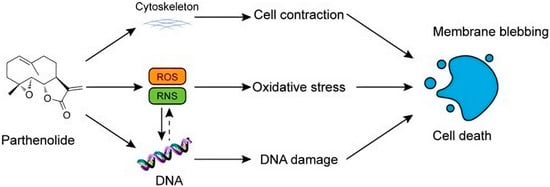
Figure 10.
The figure shows how parthenolide induces oxidative stress through the generation of ROS and RNS, leading to DNA damage, cell contraction, and membrane blebbing, ultimately resulting in cell death.
8. Luteolin
One of the most studied naturally occurring flavones among chemicals obtained from plants is luteolin (3′,4′,5,7-tetrahydroxyflavone), a subclass of flavonoids made up of a C6–C3–C6 carbon skeleton with two benzene rings connected by a heterocyclic ring Its chemical appearance is that of a yellow crystalline material with a poor water solubility, molecular weight of 286.24 g/mol, and molecular formula of C15H10O6 [].
Interestingly, the luteolin compound is also considered heat stable, meaning it does not evaporate when cooking. Studies of the structure-activity relationship showed that luteolin’s potent antioxidant activity results from the hydroxyl groups present at the sites of C5, C7, C3′, and C4′. Its ability to combat microbes is also ascribed to carbonyl oxygen at the C4 site. Furthermore, it has been determined that the biocidal activity of luteolin derived from the double bond between C2 and C3 []. Plants contain copious amounts of the luteolin molecule, which is found as an aglycone molecule without a sugar moiety and as a glycoside molecule (named LUT-7-O-glucoside or LUT-7G) with a sugar moiety, the main one being glucose. The primary distinction between luteolin’s aglycone and glycoside forms is found in their molecular structures; in the glycoside form, sugar moieties are joined by one or more hydroxyl groups. The most prevalent luteolin compound found in diets containing plant-based foods and drinks, including dark chocolate, green tea, coffee, almonds, apples, oranges, pomegranates, lemons, grapes, lettuce, spinach, seaweed, oregano, parsley, and thyme. Furthermore, when the Luteolin (aglycone form) and LUT-7-O-glucoside forms were evaluated for their respective actions, the aglycone form showed more potent antioxidant, antidiabetic, and anti-inflammatory properties [].
Luteolin’s anticancer properties have been attributed to its ability to inhibit tumor cell invasion, metastasis, and proliferation through various mechanisms, including the induction of apoptosis, suppression of kinases, regulation of the tumor cell cycle, and reduction of transcription factor activity (Figure 11).
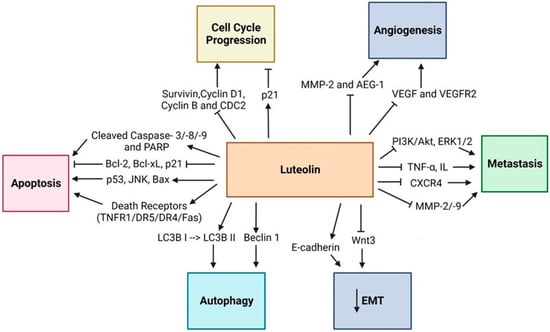
Figure 11.
The figure illustrates luteolin’s role in inducing apoptosis by activating caspases and downregulating Bcl-2 while promoting autophagy via LC3B and Beclin 1. Luteolin inhibits cell cycle progression, angiogenesis, and metastasis by targeting key molecules such as Cyclin D1, MMP-2, VEGF, and the PI3K/Akt pathway. Additionally, it suppresses epithelial-mesenchymal transition (EMT) by modulating E-cadherin and N-cadherin, highlighting its therapeutic potential in cancer.
9. Quercetin
Recently, flavonoids have been introduced as diet-derived components to combat tumor cells by modulating the pathways involved in angiogenesis, apoptosis, and proliferation. Flavonoids are naturally occurring polyphenolic compounds with several demonstrated benefits, such as anti-inflammatory, anti-diabetic, antimicrobial, anticancer, antioxidant, antiviral, and anti-allergic properties [,]. Within the flavonoid subclass of flavonols, Quercetin (QUE; 3,5,7,30,40-pentahydroxyflavone) is the primary representative. Quercetin is a dietary flavonoid that is commonly found in fruits and vegetables and is consumed in copious quantities in Western diets. One of the vegetables that is especially high in this flavanol is onions. The content of this flavonoid in 100 g of Fresh Weight (FW) of white and yellow onions ranges from 0.03 to 0.28 mg, with red onion varieties having the highest content (about 1.31 mg/100 g FW) [,]. QUE is primarily found in plants as glycosides. The hydrolysis of glycosidic bonds is catalyzed by intestinal β-glycosidases prior to their absorption by enterocytes. Here, they are converted into conjugates of quercetin []. QUE is metabolized in the liver and intestines []. QUE 3-O-glucuronide and QUE 3′-O-sulfate are the two main QUE metabolites that are found in human plasma, while parent aglycon is known to be present in the systemic circulation []. The systemic effects of QUE are influenced by its low bioavailability, which may be responsible for the variations in QUE effects observed in vitro and in vivo [,]. Quercetin modulates the PI3K/Akt/mTOR, Wnt/β-catenin, and MAPK/ERK1/2 pathways to exert its anticancer effects on cancer cells and tumors. Moreover, because quercetin reduces β-catenin and HIF-1α stabilization, activates caspase-3, and inhibits Akt, mTOR, and ERK phosphorylation, it promotes cell viability loss, apoptosis, and autophagy in cancer. Additionally, quercetin inhibits metastasis by lowering MMP and VEGF secretion. Key enzymes involved in glycolysis and glucose uptake are inhibited by QUE’s metabolic effect on cancer through disruption of the PI3K/Akt/mTOR pathways. In addition to reducing bioenergetics and inducing intrinsic apoptosis, quercetin also targets mitochondria in cancer. The reduction of cell viability, inhibition of metastasis, and induction of apoptosis in cancer cells are all influenced by QUE’s effects on glucose metabolism and cellular energy production []. The effects of quercetin are dose-dependent and biphasic. QUE has chemopreventive effects at low concentrations because it acts as an antioxidant; however, at high concentrations, it acts as a pro-oxidant and may have chemotherapeutic effects []. It has been established that QUE can prevent the in vitro proliferation of several cancer cell lines. The primary cause of QUE’s anti-proliferation effect was cell cycle arrest in the G1 phase despite a low QUE dose with a slight cytotoxic effect. This has been primarily achieved by phosphorylating the retinoblastoma tumor suppressor protein, pRb, and downregulating cyclin B1 and cyclin-dependent kinase 1 (CDK1), two critical elements of G2/M cell cycle progression []. Hypophosphorylated Rb inhibits the expression of cell proliferation genes by binding to and sequestering the transcription factor E2F1. This causes cell cycle arrest at the G1 phase []. Additionally, quercetin activated Chk2 and caused minor DNA damage, which led to the induction of p21, a cyclin-dependent kinase) inhibitor []. QUE also prevented the progression of the cell cycle from G0/G1 to G2/M at high concentrations []. Moreover, Strong anti-mitotic activity was demonstrated by quercetin, which reduced the activity of several kinases (including platelet-derived growth factor (PDGF), MET kinase, NIMA-related kinases (NEK4 and NEK9), Aurora kinases A and B, and PAKs (p21-activated kinases) by more than 80% []. It is noteworthy that QUE exhibits this effect at a low concentration (2 µM), which is less than 10% of its IC50 growth-inhibitory concentration, as determined by averaging eight different cancer cell lines (the mouse melanoma cancer cell line, human non-small cell lung cancer, glioblastoma, colon cancer, breast and prostate cancer cell lines, and melanoma) []. Moreover, Pre-treatment with 300 µM QUE significantly down-regulated the phosphorylation of Akt, PDK1, Bcl-2-associated death promoter (BAD), and the amount of tumor necrosis factor receptor 1 (TNFR1). It also suppressed the increase in H2O2-induced ROS. Additionally, in Dalton’s lymphoma ascite (DLA) cells treated with H2O2, QUE raised the amount of PTEN []. Furthermore, some research indicates that QUE’s anti-tumor effects stem from its capacity to trigger autophagy and apoptosis in cancerous cells and xenographmodels. The number of cells in the sub-G1 phase, nucleus fragmentation, activation of caspase-3 and caspase-9, and poly (ADP-ribose) polymerase protein degradation are all enhanced by quercetin. Quercetin also decreased the potential of the mitochondrial membrane in malignant glioma cells U373MG. Quercetin causes intrinsic apoptosis by activating JNK, increasing p53 expression, and translocating it to mitochondria []. Moreover, quercetin can trigger protective autophagy in breast and gastric cancer cells by inactivating the Akt-mTOR pathway and HIF-1α signaling []. Quercetin has also increased G1 phase cells and caused apoptosis, promoting PARP cleavage and nuclear fragmentation.
Furthermore, QUE has suppressed the phosphorylation of Aktser473 and mTOR, encouraged the dephosphorylation and activation of glycogen synthase kinase 3 (GSK-3), decreased the expression of pro-survival cellular proteins like c-FLIP, cyclin D1, and c-Myc, and caused the degradation of β-catenin. Additionally, QUE has reduced the phosphorylation/activation of the signal transducer and activator of transcription 3 (STAT3) Tyr705/Ser727, as well as the release of interleukin-6 (IL-6) and IL-10. The activation of STAT3 and PI3K/Akt/mTOR is mediated by these two cytokines []. The Wnt/β-catenin pathway is connected to PI3K/Akt/mTOR signaling because Akt phosphorylates GSK-3, which in turn causes its inactivation and β-catenin accumulation []. These findings suggest that QUE causes cell death by inhibiting the PI3K/Akt/mTOR and STAT3 pathways in PEL cells (Figure 12) [].

Figure 12.
This figure illustrates the mechanism by which quercetin induces apoptosis in cancer cells. Quercetin activates death receptors, leading to the activation of caspase-8. This activation triggers the cleavage of PARP and the subsequent activation of caspase-3. Concurrently, Quercetin promotes the release of cytochrome c from the mitochondria by upregulating pro-apoptotic proteins BAX and BAD, further driving apoptosome formation and caspase-3 activation, ultimately resulting in apoptosis.
10. Anthocyanins
Fruits and vegetables naturally contain glycosides called anthocyanins with low biosafety and cytotoxicity levels. Anthocyanins are a unique subclass of flavonoids that give various fruits and vegetables their red, purple, and blue color. This, in turn, enhances their appearance, one of the attributes consumers value the most. Beyond this business standpoint, anthocyanins have also been suggested as therapeutic agents for the prevention of cancer, heart disease, and some metabolic conditions like type 2 diabetes and obesity [,]. Over 500 distinct types of anthocyanins have been identified to date, and these anthocyanins are found in 72 genera and 27 families of plants []. Anthocyanins work as bacteriostatic, antioxidant, anti-inflammatory, anti-aging, and anticancer agents. 2-phenylchromenylium, also known as flavylium, is the basic structure of anthocyanin. Due to the different substituent groups of the B-ring on the basic structure, it has been discovered that the combination with glucose, galactose, and rhamnose could form a variety of anthocyanins, including pelargonidin, delphinidin, petunidin, cyanidin, and malvidin [,]. Studies have revealed that the active site, which in turn prevents tumor growth and metastasis, is the ortho-dihydroxyphenyl structure on the B-ring [,]. Moreover, Anthocyanins have been reported to have a variety of potential anti-tumor effects, which are related to antioxidant, anti-inflammation, anti-mutagenesis, induction of differentiation, inhibition of proliferation through modulation of signal transduction pathways, induction of cell cycle arrest and stimulation of apoptosis or autophagy of cancer cells, anti-invasion and anti-metastasis, reversal of drug resistance in cancer cells, and enhancement of chemotherapy sensitivity []. Moreover, Anthocyanins have a potent antioxidant potential because they can scavenge free radicals, which work to lower DNA damage and prevent the growth of tumors []. In addition, According to reports, anthocyanins have the ability to regulate the expression and secretion of inflammatory factors by blocking the transcription factor nuclear factor kappa-light-chain-enhancer of activated B cells (NF-κB) via a variety of mechanisms [,]. For instance, by acting on the PI3K/PKB and MAPK pathways, cyanidin-3-glucoside, delphinidin-3-glucoside, and petunidin-3-glucoside block the activation of NF-κB induced by external stimuli (such as lipopolysaccharide (LPS) or interferon-γ (IFN-γ)) [,], and can prevent the synthesis of prostaglandin E (PGE2) and nitric oxide (NO), as well as the expression of cyclooxygenase 2 (COX-2) and inducible nitric oxide synthase (iNOS) []. However, depending on the various substituents on their B rings, anthocyanins have varying anticancer effects. A growing body of research suggests that the primary molecular mechanism underlying their anti-tumor effects is their inhibition of cancer cell growth and metastasis through targeting RTKs (EGFR, PDGFR, and VEGF/VEGFR). Moreover, interacting with the Ras-MAPK and PI3K/Akt signal cascade pathways/pathways. At the initial stage, anthocyanin inhibits inflammation by suppressing the expression of COX-2 and iNOS through the PI3K/Akt and NF-κB pathway. This would prevent the normal cells from transforming by controlling the expression of phase II antioxidant enzymes to achieve anti-oxidation through the Nrf2/ARE signal system eventually. During the formation phase, anthocyanins would prevent carcinogenesis by targeting the MAPK and AP-1 pathways and inhibiting RTK activity and its signal cascade pathway, which in turn regulates the expression of cancer-related genes and causes cell cycle arrest and DNA repair. During the developmental stage, anthocyanins trigger caspase activation in cancer cells, facilitated by ROS and JNK/p38-MAPK (Figure 13). Moreover, anthocyanins prevent the metastatic growth of cancer by interfering with the VEGF signaling pathway and the breakdown of the extracellular matrix (ECM). Moreover, anthocyanins can increase cancer cells’ sensitivity to chemotherapy by reversing their multidrug resistance [].
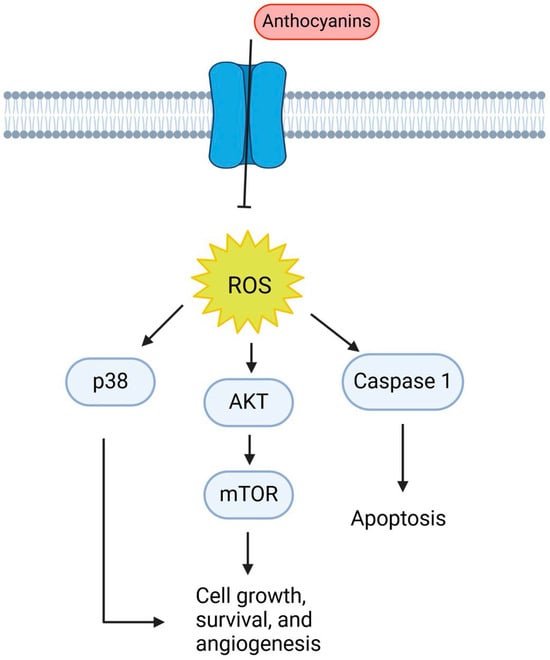
Figure 13.
The figure shows how anthocyanins induce the production of reactive oxygen species (ROS), activating multiple signaling pathways. ROS activation leads to the phosphorylation of p38 and Akt, with downstream effects on mTOR, promoting cell growth, survival, and angiogenesis. Concurrently, ROS triggers caspase-1 activation, leading to apoptosis.
11. Conclusions
In conclusion, studying natural products in the context of altered metabolism in cancer represents a captivating and promising frontier in cancer research. The intricate interplay between cellular metabolism and cancer progression has led researchers to explore the therapeutic potential of various natural compounds derived from plants, fruits, and other sources. These compounds exhibit a wide range of bioactive properties, influencing diverse metabolic pathways crucial for cancer cells’ survival and proliferation.
One of the remarkable aspects of natural products is their ability to modulate energy metabolism in cancer cells. Compounds such as resveratrol, found in grapes, and curcumin, derived from turmeric, have demonstrated the capacity to interfere with glycolysis, the Warburg effect, and mitochondrial function. By disrupting these fundamental processes, natural products have shown the potential to impair the energy production mechanisms that fuel the uncontrolled growth of cancer cells.
Moreover, the impact of natural products extends beyond energy metabolism. Compounds like quercetin and sulforaphane have been found to influence cellular redox balance and oxidative stress, contributing to the selective targeting of cancer cells while sparing normal cells. These antioxidants counteract the heightened oxidative stress characteristic of cancer cells, presenting a novel avenue for therapeutic intervention (Table 1).

Table 1.
Summary of the primary effects of natural products in cancer, with a focus on cancer metabolism.
Natural products also exhibit the ability to interfere with biosynthetic pathways critical for cancer cell survival. Polyphenols, such as epigallocatechin gallate (EGCG) from green tea, have been shown to modulate lipid metabolism and inhibit enzymes involved in nucleotide synthesis. By disrupting these biosynthetic processes, natural products exert anti-proliferative effects, hindering the uncontrolled cell division typical of cancer.
The complexity and heterogeneity of cancer metabolism demand multifaceted approaches, and natural products offer a rich source of diverse bioactive compounds. The synergistic effects of various constituents within these natural products present a holistic strategy that can target multiple aspects of altered metabolism in cancer cells. While challenges and questions remain, ongoing research endeavors aim to unravel the precise mechanisms of action, optimize dosages, and explore potential synergies between natural compounds and conventional cancer therapies.
Exploring natural products in cancer metabolism research underscores the importance of integrating traditional knowledge with modern scientific approaches and opens avenues for innovative and personalized therapeutic strategies. As we uncover the intricacies of altered metabolism in cancer, natural products stand poised as valuable allies in pursuing effective and holistic cancer treatments.
Author Contributions
Conceptualization: W.H.T.; literature review: M.M.B., M.F.B., E.A.-Z., H.K.A. and M.M.A.; writing—original draft preparation: A.A., E.W.A.-R. and R.H.Y.A.; writing—review and editing: W.H.T. and D.L. All authors have read and agreed to the published version of the manuscript.
Funding
This research was funded by the Applied Science Private University, Amman, Jordan (grant number DRGS-2024-1).
Data Availability Statement
The datasets used and analyzed during the current study are available from the corresponding author upon reasonable request.
Conflicts of Interest
The authors declare no conflicts of interest.
References
- Vernieri, C.; Casola, S.; Foiani, M.; Pietrantonio, F.; de Braud, F.; Longo, V. Targeting cancer metabolism: Dietary and pharmacologic interventions. Cancer Discov. 2016, 6, 1315–1333. [Google Scholar] [CrossRef]
- Martínez-Reyes, I.; Chandel, N.S. Cancer metabolism: Looking forward. Nat. Rev. Cancer 2021, 21, 669–680. [Google Scholar] [CrossRef]
- Martinez-Outschoorn, U.E.; Peiris-Pagés, M.; Pestell, R.G.; Sotgia, F.; Lisanti, M.P. Cancer metabolism: A therapeutic perspective. Nat. Rev. Clin. Oncol. 2017, 14, 11–31. [Google Scholar] [CrossRef]
- Koppenol, W.H.; Bounds, P.L.; Dang, C.V. Otto Warburg’s contributions to current concepts of cancer metabolism. Nat. Rev. Cancer 2011, 11, 325–337. [Google Scholar] [CrossRef]
- Warburg, O. On respiratory impairment in cancer cells. Science 1956, 124, 269–270. [Google Scholar] [CrossRef] [PubMed]
- Cantor, J.R.; Sabatini, D.M. Cancer cell metabolism: One hallmark, many faces. Cancer Discov. 2012, 2, 881–898. [Google Scholar] [CrossRef]
- Hossain, M.S.; Kader, M.A.; Goh, K.W.; Islam, M.; Khan, M.S.; Harun-Ar Rashid, M.; Ooi, D.J.; Melo Coutinho, H.D.; Al-Worafi, Y.M.; Moshawih, S. Herb and spices in colorectal cancer prevention and treatment: A narrative review. Front. Pharmacol. 2022, 13, 865801. [Google Scholar] [CrossRef]
- Reddy, L.; Odhav, B.; Bhoola, K. Natural products for cancer prevention: A global perspective. Pharmacol. Ther. 2003, 99, 1–13. [Google Scholar] [CrossRef] [PubMed]
- Atanasov, A.G.; Zotchev, S.B.; Dirsch, V.M.; Supuran, C.T. Natural products in drug discovery: Advances and opportunities. Nat. Rev. Drug Discov. 2021, 20, 200–216. [Google Scholar] [CrossRef] [PubMed]
- Zhao, Y.; Chard Dunmall, L.S.; Cheng, Z.; Wang, Y.; Si, L. Natural products targeting glycolysis in cancer. Front. Pharmacol. 2022, 13, 1036502. [Google Scholar] [CrossRef]
- Saunier, E.; Antonio, S.; Regazzetti, A.; Auzeil, N.; Laprévote, O.; Shay, J.W.; Coumoul, X.; Barouki, R.; Benelli, C.; Huc, L. Resveratrol reverses the Warburg effect by targeting the pyruvate dehydrogenase complex in colon cancer cells. Sci. Rep. 2017, 7, 6945. [Google Scholar] [CrossRef] [PubMed]
- Baudot, A.; De La Torre, V.; Valencia, A. Mutated genes, pathways and processes in tumours. EMBO Rep. 2010, 11, 805–810. [Google Scholar] [CrossRef] [PubMed]
- Reya, T.; Morrison, S.J.; Clarke, M.F.; Weissman, I.L. Stem cells, cancer, and cancer stem cells. Nature 2001, 414, 105–111. [Google Scholar] [CrossRef] [PubMed]
- Sancho, P.; Barneda, D.; Heeschen, C. Hallmarks of cancer stem cell metabolism. Br. J. Cancer 2016, 114, 1305–1312. [Google Scholar] [CrossRef]
- San-Millán, I.; Brooks, G.A. Reexamining cancer metabolism: Lactate production for carcinogenesis could be the purpose and explanation of the Warburg Effect. Carcinogenesis 2017, 38, 119–133. [Google Scholar] [CrossRef]
- Vander Heiden, M.G.; Cantley, L.C.; Thompson, C.B. Understanding the Warburg effect: The metabolic requirements of cell proliferation. Science 2009, 324, 1029–1033. [Google Scholar] [CrossRef]
- Dang, C.V. Rethinking the Warburg effect with Myc micromanaging glutamine metabolism. Cancer Res. 2010, 70, 859–862. [Google Scholar] [CrossRef]
- Semenza, G.L. HIF-1: Upstream and downstream of cancer metabolism. Curr. Opin. Genet. Dev. 2010, 20, 51–56. [Google Scholar] [CrossRef]
- Tennant, D.A.; Durán, R.V.; Gottlieb, E. Targeting metabolic transformation for cancer therapy. Nat. Rev. Cancer 2010, 10, 267–277. [Google Scholar] [CrossRef]
- Laplante, M.; Sabatini, D.M. mTOR signaling in growth control and disease. Cell 2012, 149, 274–293. [Google Scholar] [CrossRef]
- Lien, E.C.; Dibble, C.C.; Toker, A. PI3K signaling in cancer: Beyond AKT. Curr. Opin. Cell Biol. 2017, 45, 62–71. [Google Scholar] [CrossRef] [PubMed]
- Lien, E.C.; Lyssiotis, C.A.; Cantley, L.C. Metabolic reprogramming by the PI3K-Akt-mTOR pathway in cancer. In Metabolism in Cancer; Springer: Berlin/Heidelberg, Germany, 2016; pp. 39–72. [Google Scholar]
- Marbaniang, C.; Kma, L. Dysregulation of glucose metabolism by oncogenes and tumor suppressors in cancer cells. Asian Pac. J. Cancer Prev. APJCP 2018, 19, 2377. [Google Scholar] [PubMed]
- Dejure, F.R.; Eilers, M. MYC and tumor metabolism: Chicken and egg. EMBO J. 2017, 36, 3409–3420. [Google Scholar] [CrossRef]
- Soni, S.; Padwad, Y.S. HIF-1 in cancer therapy: Two decade long story of a transcription factor. Acta Oncol. 2017, 56, 503–515. [Google Scholar] [CrossRef]
- DeNicola, G.M.; Cantley, L.C. Cancer’s fuel choice: New flavors for a picky eater. Mol. Cell 2015, 60, 514–523. [Google Scholar] [CrossRef]
- Lu, H.; Forbes, R.A.; Verma, A. Hypoxia-inducible factor 1 activation by aerobic glycolysis implicates the Warburg effect in carcinogenesis. J. Biol. Chem. 2002, 277, 23111–23115. [Google Scholar] [CrossRef] [PubMed]
- Desideri, E.; Vegliante, R.; Ciriolo, M.R. Mitochondrial dysfunctions in cancer: Genetic defects and oncogenic signaling impinging on TCA cycle activity. Cancer Lett. 2015, 356, 217–223. [Google Scholar] [CrossRef]
- Nagao, A.; Kobayashi, M.; Koyasu, S.; Chow, C.C.; Harada, H. HIF-1-dependent reprogramming of glucose metabolic pathway of cancer cells and its therapeutic significance. Int. J. Mol. Sci. 2019, 20, 238. [Google Scholar] [CrossRef]
- Semenza, G.L. Hypoxia-inducible factor 1: Oxygen homeostasis and disease pathophysiology. Trends Mol. Med. 2001, 7, 345–350. [Google Scholar] [CrossRef]
- Shrestha, A.; Pandey, R.P.; Sohng, J.K. Biosynthesis of resveratrol and piceatannol in engineered microbial strains: Achievements and perspectives. Appl. Microbiol. Biotechnol. 2019, 103, 2959–2972. [Google Scholar] [CrossRef]
- Stagos, D.; Amoutzias, G.D.; Matakos, A.; Spyrou, A.; Tsatsakis, A.M.; Kouretas, D. Chemoprevention of liver cancer by plant polyphenols. Food Chem. Toxicol. 2012, 50, 2155–2170. [Google Scholar] [CrossRef] [PubMed]
- Leonard, S.S.; Xia, C.; Jiang, B.-H.; Stinefelt, B.; Klandorf, H.; Harris, G.K.; Shi, X. Resveratrol scavenges reactive oxygen species and effects radical-induced cellular responses. Biochem. Biophys. Res. Commun. 2003, 309, 1017–1026. [Google Scholar] [CrossRef]
- Sarkar, F.H.; Li, Y.; Wang, Z.; Kong, D. Cellular signaling perturbation by natural products. Cell. Signal. 2009, 21, 1541–1547. [Google Scholar] [CrossRef]
- Jang, M.; Cai, L.; Udeani, G.O.; Slowing, K.V.; Thomas, C.F.; Beecher, C.W.; Fong, H.H.; Farnsworth, N.R.; Kinghorn, A.D.; Mehta, R.G. Cancer chemopreventive activity of resveratrol, a natural product derived from grapes. Science 1997, 275, 218–220. [Google Scholar] [CrossRef] [PubMed]
- Nishioka, T.; Oda, Y.; Seino, Y.; Yamamoto, T.; Inagaki, N.; Yano, H.; Imura, H.; Shigemoto, R.; Kikuchi, H. Distribution of the glucose transporters in human brain tumors. Cancer Res. 1992, 52, 3972–3979. [Google Scholar] [PubMed]
- Yamamoto, T.; Seino, Y.; Fukumoto, H.; Koh, G.; Yano, H.; Inagaki, N.; Yamada, Y.; Inoue, K.; Manabe, T.; Imura, H. Over-expression of facilitative glucose transporter genes in human cancer. Biochem. Biophys. Res. Commun. 1990, 170, 223–230. [Google Scholar] [CrossRef]
- Liu, Y.; Cao, Y.; Zhang, W.; Bergmeier, S.; Qian, Y.; Akbar, H.; Colvin, R.; Ding, J.; Tong, L.; Wu, S. A small-molecule inhibitor of glucose transporter 1 downregulates glycolysis, induces cell-cycle arrest, and inhibits cancer cell growth in vitro and in vivo. Mol. Cancer Ther. 2012, 11, 1672–1682. [Google Scholar] [CrossRef] [PubMed]
- Liu, Y.; Zhang, W.; Cao, Y.; Liu, Y.; Bergmeier, S.; Chen, X. Small compound inhibitors of basal glucose transport inhibit cell proliferation and induce apoptosis in cancer cells via glucose-deprivation-like mechanisms. Cancer Lett. 2010, 298, 176–185. [Google Scholar] [CrossRef]
- Iqbal, M.A.; Bamezai, R.N. Resveratrol inhibits cancer cell metabolism by down regulating pyruvate kinase M2 via inhibition of mammalian target of rapamycin. PLoS ONE 2012, 7, e36764. [Google Scholar] [CrossRef]
- Lin, J.-N.; Lin, V.C.-H.; Rau, K.-M.; Shieh, P.-C.; Kuo, D.-H.; Shieh, J.-C.; Chen, W.-J.; Tsai, S.-C.; Way, T.-D. Resveratrol modulates tumor cell proliferation and protein translation via SIRT1-dependent AMPK activation. J. Agric. Food Chem. 2010, 58, 1584–1592. [Google Scholar] [CrossRef]
- Kueck, A.; Opipari Jr, A.W.; Griffith, K.A.; Tan, L.; Choi, M.; Huang, J.; Wahl, H.; Liu, J.R. Resveratrol inhibits glucose metabolism in human ovarian cancer cells. Gynecol. Oncol. 2007, 107, 450–457. [Google Scholar] [CrossRef] [PubMed]
- Opipari Jr, A.W.; Tan, L.; Boitano, A.E.; Sorenson, D.R.; Aurora, A.; Liu, J.R. Resveratrol-induced autophagocytosis in ovarian cancer cells. Cancer Res. 2004, 64, 696–703. [Google Scholar] [CrossRef] [PubMed]
- Gwak, H.; Haegeman, G.; Tsang, B.K.; Song, Y.S. Cancer-specific interruption of glucose metabolism by resveratrol is mediated through inhibition of Akt/GLUT1 axis in ovarian cancer cells. Mol. Carcinog. 2015, 54, 1529–1540. [Google Scholar] [CrossRef]
- Thompson, C. Rethinking the regulation of cellular metabolism. In Cold Spring Harbor Symposia on Quantitative Biology; Cold Spring Harbor Laboratory Press: Berlin/Heidelberg, Germany, 2011; pp. 23–29. [Google Scholar]
- Rolfe, D.; Brown, G.C. Cellular energy utilization and molecular origin of standard metabolic rate in mammals. Physiol. Rev. 1997, 77, 731–758. [Google Scholar] [CrossRef]
- Warburg, O.; Wind, F.; Negelein, E. The metabolism of tumors in the body. J. Gen. Physiol. 1927, 8, 519. [Google Scholar] [CrossRef]
- Brockmueller, A.; Sameri, S.; Liskova, A.; Zhai, K.; Varghese, E.; Samuel, S.M.; Büsselberg, D.; Kubatka, P.; Shakibaei, M. Resveratrol’s Anti-Cancer Effects through the Modulation of Tumor Glucose Metabolism. Cancers 2021, 13, 188. [Google Scholar] [CrossRef]
- Yao, Y.; Zhu, J.; Qin, S.; Zhou, Z.; Zeng, Q.; Long, R.; Mao, Z.; Dong, X.; Zhao, R.; Zhang, R. Resveratrol induces autophagy impeding BAFF-stimulated B-cell proliferation and survival by inhibiting the Akt/mTOR pathway. Biochem. Pharmacol. 2022, 202, 115139. [Google Scholar] [CrossRef] [PubMed]
- Shamim, U.; Hanif, S.; Albanyan, A.; Beck, F.W.; Bao, B.; Wang, Z.; Banerjee, S.; Sarkar, F.H.; Mohammad, R.M.; Hadi, S.M. Resveratrol-induced apoptosis is enhanced in low pH environments associated with cancer. J. Cell. Physiol. 2012, 227, 1493–1500. [Google Scholar] [CrossRef]
- Ahn, Y.S.; Chemeris, G.Y.; Turusov, V.S.; Bannasch, P. Enzymic pattern of preneoplastic and neoplastic lesions induced in the kidney of CBA mice by 1, 2-dimethylhydrazine. Toxicol. Pathol. 1994, 22, 415–422. [Google Scholar] [CrossRef]
- D’Alessandro, A.; Amelio, I.; Berkers, C.R.; Antonov, A.; Vousden, K.H.; Melino, G.; Zolla, L. Metabolic effect of TAp63α: Enhanced glycolysis and pentose phosphate pathway, resulting in increased antioxidant defense. Oncotarget 2014, 5, 7722. [Google Scholar] [CrossRef][Green Version]
- Jonas, S.; Benedetto, C.; Flatman, A.; Hammond, R.; Micheletti, L.; Riley, C.; Riley, P.; Spargo, D.; Zonca, M.; Slater, T. Increased activity of 6-phosphogluconate dehydrogenase and glucose-6-phosphate dehydrogenase in purified cell suspensions and single cells from the uterine cervix in cervical intraepithelial neoplasia. Br. J. Cancer 1992, 66, 185–191. [Google Scholar] [CrossRef] [PubMed]
- Lucarelli, G.; Galleggiante, V.; Rutigliano, M.; Sanguedolce, F.; Cagiano, S.; Bufo, P.; Lastilla, G.; Maiorano, E.; Ribatti, D.; Giglio, A. Metabolomic profile of glycolysis and the pentose phosphate pathway identifies the central role of glucose-6-phosphate dehydrogenase in clear cell-renal cell carcinoma. Oncotarget 2015, 6, 13371. [Google Scholar] [CrossRef]
- Sukhatme, V.P.; Chan, B. Glycolytic cancer cells lacking 6-phosphogluconate dehydrogenase metabolize glucose to induce senescence. FEBS Lett. 2012, 586, 2389–2395. [Google Scholar] [CrossRef] [PubMed]
- Le, A.; Cooper, C.R.; Gouw, A.M.; Dinavahi, R.; Maitra, A.; Deck, L.M.; Royer, R.E.; Vander Jagt, D.L.; Semenza, G.L.; Dang, C.V. Inhibition of lactate dehydrogenase A induces oxidative stress and inhibits tumor progression. Proc. Natl. Acad. Sci. USA 2010, 107, 2037–2042. [Google Scholar] [CrossRef]
- Mazurek, S.; Boschek, C.B.; Hugo, F.; Eigenbrodt, E. Pyruvate kinase type M2 and its role in tumor growth and spreading. In Seminars in Cancer Biology; Elsevier: Amsterdam, The Netherlands, 2005; pp. 300–308. [Google Scholar]
- DeBerardinis, R.J.; Sayed, N.; Ditsworth, D.; Thompson, C.B. Brick by brick: Metabolism and tumor cell growth. Curr. Opin. Genet. Dev. 2008, 18, 54–61. [Google Scholar] [CrossRef] [PubMed]
- Ahmadian, M.; Duncan, R.E.; Jaworski, K.; Sarkadi-Nagy, E.; Sook Sul, H. Triacylglycerol metabolism in adipose tissue. Future Lipidol. 2007, 2, 229–237. [Google Scholar] [CrossRef]
- Baenke, F.; Peck, B.; Miess, H.; Schulze, A. Hooked on fat: The role of lipid synthesis in cancer metabolism and tumour development. Dis. Models Mech. 2013, 6, 1353–1363. [Google Scholar] [CrossRef]
- Harris, D.M.; Li, L.; Chen, M.; Lagunero, F.T.; Go, V.L.W.; Boros, L.G. Diverse mechanisms of growth inhibition by luteolin, resveratrol, and quercetin in MIA PaCa-2 cells: A comparative glucose tracer study with the fatty acid synthase inhibitor C75. Metabolomics 2012, 8, 201–210. [Google Scholar] [CrossRef]
- Buckley, D.; Duke, G.; Heuer, T.S.; O’Farrell, M.; Wagman, A.S.; McCulloch, W.; Kemble, G. Fatty acid synthase–modern tumor cell biology insights into a classical oncology target. Pharmacol. Ther. 2017, 177, 23–31. [Google Scholar] [CrossRef]
- Flavin, R.; Peluso, S.; Nguyen, P.L.; Loda, M. Fatty acid synthase as a potential therapeutic target in cancer. Future Oncol. 2010, 6, 551–562. [Google Scholar] [CrossRef]
- Jiao, Y.; Li, H.; Liu, Y.; Guo, A.; Xu, X.; Qu, X.; Wang, S.; Zhao, J.; Li, Y.; Cao, Y. Resveratrol inhibits the invasion of glioblastoma-initiating cells via down-regulation of the PI3K/Akt/NF-κB signaling pathway. Nutrients 2015, 7, 4383–4402. [Google Scholar] [CrossRef] [PubMed]
- Khan, A.; Aljarbou, A.N.; Aldebasi, Y.H.; Faisal, S.M.; Khan, M.A. Resveratrol suppresses the proliferation of breast cancer cells by inhibiting fatty acid synthase signaling pathway. Cancer Epidemiol. 2014, 38, 765–772. [Google Scholar] [CrossRef]
- Han, J.; Wang, Y. mTORC1 signaling in hepatic lipid metabolism. Protein Cell 2018, 9, 145–151. [Google Scholar] [CrossRef] [PubMed]
- Saxton, R.A.; Sabatini, D.M. mTOR signaling in growth, metabolism, and disease. Cell 2017, 168, 960–976. [Google Scholar] [CrossRef]
- Chai, R.; Fu, H.; Zheng, Z.; Liu, T.; Ji, S.; Li, G. Resveratrol inhibits proliferation and migration through SIRT1 mediated post-translational modification of PI3K/AKT signaling in hepatocellular carcinoma cells. Mol. Med. Rep. 2017, 16, 8037–8044. [Google Scholar] [CrossRef]
- Jing, X.; Cheng, W.; Wang, S.; Li, P.; He, L. Resveratrol induces cell cycle arrest in human gastric cancer MGC803 cells via the PTEN-regulated PI3K/Akt signaling pathway. Oncol. Rep. 2016, 35, 472–478. [Google Scholar] [CrossRef]
- Long, J.; Zhang, C.-J.; Zhu, N.; Du, K.; Yin, Y.-F.; Tan, X.; Liao, D.-F.; Qin, L. Lipid metabolism and carcinogenesis, cancer development. Am. J. Cancer Res. 2018, 8, 778. [Google Scholar]
- Wong, D.H.; Villanueva, J.A.; Cress, A.B.; Sokalska, A.; Ortega, I.; Duleba, A.J. Resveratrol inhibits the mevalonate pathway and potentiates the antiproliferative effects of simvastatin in rat theca-interstitial cells. Fertil. Steril. 2011, 96, 1252–1258. [Google Scholar] [CrossRef] [PubMed]
- Hardie, D.G. AMP-activated/SNF1 protein kinases: Conserved guardians of cellular energy. Nat. Rev. Mol. Cell Biol. 2007, 8, 774–785. [Google Scholar] [CrossRef]
- Fan, L.; Cacicedo, J.M.; Ido, Y. Activation of AMPKK-AMPK cascade by silence information regulator 2 (sir2). Diabetes 2005, 54, A383. [Google Scholar]
- Lan, F.; Weikel, K.A.; Cacicedo, J.M.; Ido, Y. Resveratrol-induced AMP-activated protein kinase activation is cell-type dependent: Lessons from basic research for clinical application. Nutrients 2017, 9, 751. [Google Scholar] [CrossRef] [PubMed]
- Price, N.L.; Gomes, A.P.; Ling, A.J.; Duarte, F.V.; Martin-Montalvo, A.; North, B.J.; Agarwal, B.; Ye, L.; Ramadori, G.; Teodoro, J.S.; et al. SIRT1 is required for AMPK activation and the beneficial effects of resveratrol on mitochondrial function. Cell Metab. 2012, 15, 675–690. [Google Scholar] [CrossRef] [PubMed]
- Mei, Z.; Zhang, X.; Yi, J.; Huang, J.; He, J.; Tao, Y. Sirtuins in metabolism, DNA repair and cancer. J. Exp. Clin. Cancer Res. 2016, 35, 182. [Google Scholar] [CrossRef]
- Li, X.; Zhang, S.; Blander, G.; Tse, J.G.; Krieger, M.; Guarente, L. SIRT1 deacetylates and positively regulates the nuclear receptor LXR. Mol. Cell 2007, 28, 91–106. [Google Scholar] [CrossRef]
- Nogueiras, R.; Habegger, K.M.; Chaudhary, N.; Finan, B.; Banks, A.S.; Dietrich, M.O.; Horvath, T.L.; Sinclair, D.A.; Pfluger, P.T.; Tschöp, M.H. Sirtuin 1 and sirtuin 3: Physiological modulators of metabolism. Physiol. Rev. 2012, 92, 1479–1514. [Google Scholar] [CrossRef]
- Shehzad, A.; Ha, T.; Subhan, F.; Lee, Y.S. New mechanisms and the anti-inflammatory role of curcumin in obesity and obesity-related metabolic diseases. Eur. J. Nutr. 2011, 50, 151–161. [Google Scholar] [CrossRef] [PubMed]
- Shehzad, A.; Wahid, F.; Lee, Y.S. Curcumin in cancer chemoprevention: Molecular targets, pharmacokinetics, bioavailability, and clinical trials. Arch. Pharm. 2010, 343, 489–499. [Google Scholar] [CrossRef]
- Somparn, P.; Phisalaphong, C.; Nakornchai, S.; Unchern, S.; Morales, N.P. Comparative antioxidant activities of curcumin and its demethoxy and hydrogenated derivatives. Biol. Pharm. Bull. 2007, 30, 74–78. [Google Scholar] [CrossRef]
- Shehzad, A.; Khan, S.; Shehzad, O.; Lee, Y.S. Curcumin therapeutic promises and bioavailability in colorectal cancer. Drugs Today 2010, 46, 523–532. [Google Scholar] [CrossRef]
- Bayat Mokhtari, R.; Homayouni, T.S.; Baluch, N.; Morgatskaya, E.; Kumar, S.; Das, B.; Yeger, H. Combination therapy in combating cancer. Oncotarget 2017, 8, 38022–38043. [Google Scholar] [CrossRef]
- Tan, B.L.; Norhaizan, M.E. Curcumin Combination Chemotherapy: The Implication and Efficacy in Cancer. Molecules 2019, 24, 2527. [Google Scholar] [CrossRef]
- Qiao, Q.; Jiang, Y.; Li, G. Inhibition of the PI3K/AKT-NF-κB pathway with curcumin enhanced radiation-induced apoptosis in human Burkitt’s lymphoma. J. Pharmacol. Sci. 2013, 121, 247–256. [Google Scholar] [CrossRef] [PubMed]
- Zhang, M.; Du, H.; Huang, Z.; Zhang, P.; Yue, Y.; Wang, W.; Liu, W.; Zeng, J.; Ma, J.; Chen, G.; et al. Thymoquinone induces apoptosis in bladder cancer cell via endoplasmic reticulum stress-dependent mitochondrial pathway. Chem.-Biol. Interact. 2018, 292, 65–75. [Google Scholar] [CrossRef] [PubMed]
- Chen, M.C.; Lee, N.H.; Hsu, H.H.; Ho, T.J.; Tu, C.C.; Hsieh, D.J.; Lin, Y.M.; Chen, L.M.; Kuo, W.W.; Huang, C.Y. Thymoquinone induces caspase-independent, autophagic cell death in CPT-11-resistant lovo colon cancer via mitochondrial dysfunction and activation of JNK and p38. J. Agric. Food Chem. 2015, 63, 1540–1546. [Google Scholar] [CrossRef]
- Pandita, A.; Kumar, B.; Manvati, S.; Vaishnavi, S.; Singh, S.K.; Bamezai, R.N. Synergistic combination of gemcitabine and dietary molecule induces apoptosis in pancreatic cancer cells and down regulates PKM2 expression. PLoS ONE 2014, 9, e107154. [Google Scholar] [CrossRef] [PubMed]
- Salim, L.Z.A.; Mohan, S.; Othman, R.; Abdelwahab, S.I.; Kamalidehghan, B.; Sheikh, B.Y.; Ibrahim, M.Y. Thymoquinone induces mitochondria-mediated apoptosis in acute lymphoblastic leukaemia in vitro. Molecules 2013, 18, 11219–11240. [Google Scholar] [CrossRef] [PubMed]
- Blumenthal, M.; Goldberg, A.; Brinckmann, J. Herbal Medicine. Expanded Commission E Monographs; Integrative Medicine Communications: Newton, MA, USA, 2000. [Google Scholar]
- Gardner, C.D.; Lawson, L.D.; Block, E.; Chatterjee, L.M.; Kiazand, A.; Balise, R.R.; Kraemer, H.C. Effect of raw garlic vs commercial garlic supplements on plasma lipid concentrations in adults with moderate hypercholesterolemia: A randomized clinical trial. Arch. Intern. Med. 2007, 167, 346–353. [Google Scholar] [CrossRef]
- Valko, M.; Leibfritz, D.; Moncol, J.; Cronin, M.T.; Mazur, M.; Telser, J. Free radicals and antioxidants in normal physiological functions and human disease. Int. J. Biochem. Cell Biol. 2007, 39, 44–84. [Google Scholar] [CrossRef]
- Chen, H.; Zhu, B.; Zhao, L.; Liu, Y.; Zhao, F.; Feng, J.; Jin, Y.; Sun, J.; Geng, R.; Wei, Y. Allicin inhibits proliferation and invasion in vitro and in vivo via SHP-1-mediated STAT3 signaling in cholangiocarcinoma. Cell. Physiol. Biochem. 2018, 47, 641–653. [Google Scholar] [CrossRef]
- Li, X.; Ni, J.; Tang, Y.; Wang, X.; Tang, H.; Li, H.; Zhang, S.; Shen, X. Allicin inhibits mouse colorectal tumorigenesis through suppressing the activation of STAT3 signaling pathway. Nat. Prod. Product. Res. 2019, 33, 2722–2725. [Google Scholar] [CrossRef]
- Padilla-Camberos, E.; Zaitseva, G.; Padilla, C.; Puebla, A.M. Antitumoral activity of allicin in murine lymphoma L5178Y. Asian Pac. J. Cancer Prev. 2010, 11, 1241–1244. [Google Scholar]
- Zhang, Z.-M.; Zhong, N.; Gao, H.-Q.; Zhang, S.-Z.; Wei, Y.; Xin, H.; Mei, X.; Hou, H.-S.; Lin, X.-Y.; Shi, Q. Inducing apoptosis and upregulation of Bax and Fas ligand expression by allicin in hepatocellular carcinoma in Balb/c nude mice. Chin. Med. J. 2006, 119, 422–425. [Google Scholar] [CrossRef] [PubMed]
- Pavese, J.M.; Farmer, R.L.; Bergan, R.C. Inhibition of cancer cell invasion and metastasis by genistein. Cancer Metastasis Rev. 2010, 29, 465–482. [Google Scholar] [CrossRef]
- Sharifi-Rad, J.; Quispe, C.; Imran, M.; Rauf, A.; Nadeem, M.; Gondal, T.A.; Ahmad, B.; Atif, M.; Mubarak, M.S.; Sytar, O.; et al. Genistein: An integrative overview of its mode of action, pharmacological properties, and health benefits. Oxidative Med. Cell. Longev. 2021, 2021, 3268136. [Google Scholar] [CrossRef]
- Banerjee, S.; Li, Y.; Wang, Z.; Sarkar, F.H. Multi-targeted therapy of cancer by genistein. Cancer Lett. 2008, 269, 226–242. [Google Scholar] [CrossRef] [PubMed]
- Mukund, V.; Mukund, D.; Sharma, V.; Mannarapu, M.; Alam, A. Genistein: Its role in metabolic diseases and cancer. Crit. Rev. Oncol. Hematol. 2017; 119, 13–22. [Google Scholar]
- Tuli, H.S.; Tuorkey, M.J.; Thakral, F.; Sak, K.; Kumar, M.; Sharma, A.K.; Sharma, U.; Jain, A.; Aggarwal, V.; Bishayee, A. Molecular mechanisms of action of genistein in cancer: Recent advances. Front. Pharmacol. 2019, 10, 1336. [Google Scholar] [CrossRef] [PubMed]
- Russo, M.; Russo, G.L.; Daglia, M.; Kasi, P.D.; Ravi, S.; Nabavi, S.F.; Nabavi, S.M. Understanding genistein in cancer: The “good” and the “bad” effects: A review. Food Chem. 2016, 196, 589–600. [Google Scholar] [CrossRef]
- Du, G.-J.; Zhang, Z.; Wen, X.-D.; Yu, C.; Calway, T.; Yuan, C.-S.; Wang, C.-Z. Epigallocatechin Gallate (EGCG) is the most effective cancer chemopreventive polyphenol in green tea. Nutrients 2012, 4, 1679–1691. [Google Scholar] [CrossRef]
- Wood, C.G. Multimodal approaches in the management of locally advanced and metastatic renal cell carcinoma: Combining surgery and systemic therapies to improve patient outcome. Clin. Cancer Res. 2007, 13, 697s–702s. [Google Scholar] [CrossRef]
- Wang, L.; Li, P.; Feng, K. EGCG adjuvant chemotherapy: Current status and future perspectives. Eur. J. Med. Chem. 2023, 250, 115197. [Google Scholar] [CrossRef]
- Rather, R.A.; Bhagat, M. Cancer chemoprevention and piperine: Molecular mechanisms and therapeutic opportunities. Front. Cell Dev. Biol. 2018, 6, 10. [Google Scholar] [CrossRef] [PubMed]
- Zadorozhna, M.; Tataranni, T.; Mangieri, D. Piperine: Role in prevention and progression of cancer. Mol. Biol. Rep. 2019, 46, 5617–5629. [Google Scholar] [CrossRef]
- Mitra, S.; Anand, U.; Jha, N.K.; Shekhawat, M.S.; Saha, S.C.; Nongdam, P.; Rengasamy, K.R.R.; Proćków, J.; Dey, A. Anticancer applications and pharmacological properties of piperidine and piperine: A comprehensive review on molecular mechanisms and therapeutic perspectives. Front. Pharmacol. 2022, 12, 772418. [Google Scholar] [CrossRef] [PubMed]
- Benayad, S.; Wahnou, H.; El Kebbaj, R.; Liagre, B.; Sol, V.; Oudghiri, M.; Saad, E.M.; Duval, R.E.; Limami, Y. The promise of Piperine in cancer chemoprevention. Cancers 2023, 15, 5488. [Google Scholar] [CrossRef] [PubMed]
- Turrini, E.; Sestili, P.; Fimognari, C. Overview of the anticancer potential of the “king of spices” piper nigrum and its main constituent piperine. Toxins 2020, 12, 747. [Google Scholar] [CrossRef]
- Wei, W.T.; Lin, S.Z.; Liu, D.L.; Wang, Z.H. The distinct mechanisms of the antitumor activity of emodin in different types of cancer (Review). Oncol. Rep. 2013, 30, 2555–2562. [Google Scholar] [CrossRef]
- Hsu, S.C.; Chung, J.G. Anticancer potential of emodin. Biomed. Pharmacother. 2012, 2, 108–116. [Google Scholar] [CrossRef]
- Hu, N.; Liu, J.; Xue, X.; Li, Y. The effect of emodin on liver disease—Comprehensive advances in molecular mechanisms. Eur. J. Pharmacol. 2020, 882, 173269. [Google Scholar] [CrossRef]
- Iwanowycz, S.; Wang, J.; Hodge, J.; Wang, Y.; Yu, F.; Fan, D. Emodin Inhibits Breast Cancer Growth by Blocking the Tumor-Promoting Feedforward Loop between Cancer Cells and Macrophages. Mol. Cancer Ther. 2016, 15, 1931–1942. [Google Scholar] [CrossRef]
- Lu, J.; Xu, Y.; Wei, X.; Zhao, Z.; Xue, J.; Liu, P. Emodin Inhibits the Epithelial to Mesenchymal Transition of Epithelial Ovarian Cancer Cells via ILK/GSK-3<i>β</i>/Slug Signaling Pathway. BioMed Res. Int. 2016, 2016, 6253280. [Google Scholar]
- Galiardi-Campoy, A.E.B.; Machado, F.C.; Carvalho, T.; Tedesco, A.C.; Rahal, P.; Calmon, M.F. Effects of photodynamic therapy mediated by emodin in cervical carcinoma cells. Photodiagn. Photodyn. Ther. 2021, 35, 102394. [Google Scholar] [CrossRef] [PubMed]
- Zhang, N.; Wang, J.; Sheng, A.; Huang, S.; Tang, Y.; Ma, S.; Hong, G. Emodin Inhibits the proliferation of MCF-7 human breast cancer cells through activation of aryl hydrocarbon receptor (AhR). Front. Pharmacol. 2021, 11, 622046. [Google Scholar] [CrossRef] [PubMed]
- Wang, K.-j.; Meng, X.-y.; Chen, J.-f.; Wang, K.-y.; Zhou, C.; Yu, R.; Ma, Q. Emodin induced necroptosis and inhibited glycolysis in the renal cancer cells by enhancing ROS. Oxidative Med. Cell. Longev. 2021, 2021, 8840590. [Google Scholar] [CrossRef] [PubMed]
- Liu, Q.; Hodge, J.; Wang, J.; Wang, Y.; Wang, L.; Singh, U.; Li, Y.; Yao, Y.; Wang, D.; Ai, W.; et al. Emodin reduces Breast Cancer Lung Metastasis by suppressing Macrophage-induced Breast Cancer Cell Epithelial-mesenchymal transition and Cancer Stem Cell formation. Theranostics 2020, 10, 8365–8381. [Google Scholar] [CrossRef]
- Dong, X.; Ni, B.; Fu, J.; Yin, X.; You, L.; Leng, X.; Liang, X.; Ni, J. Emodin induces apoptosis in human hepatocellular carcinoma HepaRG cells via the mitochondrial caspase-dependent pathway. Oncol. Rep. 2018, 40, 1985–1993. [Google Scholar] [CrossRef]
- Ma, Q.; Ding, Y.; Wu, Z.; Li, Y. Antitumor effects of emodin in CACO-2 human colon carcinoma cells are mediated via apoptosis, cell cycle arrest and downregulation of PI3K/AKT signalling pathway. J. Buon 2018, 23, 587–591. [Google Scholar]
- Dai, G.; Ding, K.; Cao, Q.; Xu, T.; He, F.; Liu, S.; Ju, W. Emodin suppresses growth and invasion of colorectal cancer cells by inhibiting VEGFR2. Eur. J. Pharmacol. 2019, 859, 172525. [Google Scholar] [CrossRef]
- Lin, W.; Zhong, M.; Yin, H.; Chen, Y.; Cao, Q.; Wang, C.; Ling, C. Emodin induces hepatocellular carcinoma cell apoptosis through MAPK and PI3K/AKT signaling pathways in vitro and in vivo. Oncol. Rep. 2016, 36, 961–967. [Google Scholar] [CrossRef]
- Su, J.; Yan, Y.; Qu, J.; Xue, X.; Liu, Z.; Cai, H. Emodin induces apoptosis of lung cancer cells through ER stress and the TRIB3/NF-κB pathway. Oncol. Rep. 2017, 37, 1565–1572. [Google Scholar] [CrossRef]
- Ma, L.; Chen, K.; Jiang, K.; Deng, G.; Jiang, P.; Shao, J.; Yu, Z. Emodin inhibits the proliferation and invasion of bladder cancer cells via down-regulating Notch1. Int. J. Clin. Exp. Pathol. 2017, 10, 9452–9459. [Google Scholar]
- Ghantous, A.; Sinjab, A.; Herceg, Z.; Darwiche, N. Parthenolide: From plant shoots to cancer roots. Drug Discov. Today 2013, 18, 894–905. [Google Scholar] [CrossRef] [PubMed]
- Wiedhopf, R.M.; Young, M.; Bianchi, E.; Cole, J.R. Tumor Inhibitory Agent from Magnolia grandiflora (Magnoliaceae) I: Parthenolide. J. Pharm. Sci. 1973, 62, 345. [Google Scholar] [CrossRef] [PubMed]
- Nakshatri, H.; Sweeney, C.J. Use of Parthenolide to Inhibit Cancer. U.S. Patent No. 6,890,946, 10 May 2005. [Google Scholar]
- Araújo, T.G.; Vecchi, L.; Lima, P.; Ferreira, E.A.; Campos, I.M.; Brandão, D.C.; Guimarães, G.S.; Ribeiro, M.A.; Filho, A. Parthenolide and its Analogues: A New Potential Strategy for the Treatment of Triple-Negative Breast Tumors. Curr. Med. Chem. 2020, 27, 6628–6642. [Google Scholar] [CrossRef] [PubMed]
- Dandawate, P.R.; Subramaniam, D.; Jensen, R.A.; Anant, S. Targeting cancer stem cells and signaling pathways by phytochemicals: Novel approach for breast cancer therapy. Semin. Cancer Biol. 2016, 40–41, 192–208. [Google Scholar] [CrossRef]
- Freund, R.R.A.; Gobrecht, P.; Fischer, D.; Arndt, H.-D. Advances in chemistry and bioactivity of parthenolide. Nat. Prod. Product. Rep. 2020, 37, 541–565. [Google Scholar] [CrossRef]
- Koprowska, K.; Czyz, M. Molecular mechanisms of parthenolide’s action: Old drug with a new face. Postep. Hig. Med. Dosw. 2010, 64, 100–114. [Google Scholar]
- Kreuger, M.R.; Grootjans, S.; Biavatti, M.W.; Vandenabeele, P.; D’Herde, K. Sesquiterpene lactones as drugs with multiple targets in cancer treatment: Focus on parthenolide. Anticancer Drugs 2012, 23, 883–896. [Google Scholar] [CrossRef]
- Mathema, V.B.; Koh, Y.S.; Thakuri, B.C.; Sillanpää, M. Parthenolide, a sesquiterpene lactone, expresses multiple anti-cancer and anti-inflammatory activities. Inflammation 2012, 35, 560–565. [Google Scholar] [CrossRef]
- Ren, Y.; Yu, J.; Kinghorn, A.D. Development of Anticancer Agents from Plant-Derived Sesquiterpene Lactones. Curr. Med. Chem. 2016, 23, 2397–2420. [Google Scholar] [CrossRef]
- Siveen, K.S.; Uddin, S.; Mohammad, R.M. Targeting acute myeloid leukemia stem cell signaling by natural products. Mol. Cancer 2017, 16, 13. [Google Scholar] [CrossRef]
- Sztiller-Sikorska, M.; Czyz, M. Parthenolide as Cooperating Agent for Anti-Cancer Treatment of Various Malignancies. Pharmaceuticals 2020, 13, 194. [Google Scholar] [CrossRef]
- Wyrębska, A.; Gach, K.; Janecka, A. Combined effect of parthenolide and various anti-cancer drugs or anticancer candidate substances on malignant cells in vitro and in vivo. Mini Rev. Med. Chem. 2014, 14, 222–228. [Google Scholar] [CrossRef]
- Marino, S.; Bishop, R.T.; Carrasco, G.; Logan, J.G.; Li, B.; Idris, A.I. Pharmacological Inhibition of NFκB Reduces Prostate Cancer Related Osteoclastogenesis In Vitro and Osteolysis Ex Vivo. Calcif. Tissue Int. 2019, 105, 193–204. [Google Scholar] [CrossRef] [PubMed]
- Yi, J.; Wang, L.; Wang, X.Y.; Sun, J.; Yin, X.Y.; Hou, J.X.; Chen, J.; Xie, B.; Wei, H.L. Suppression of Aberrant Activation of NF-κB Pathway in Drug-resistant Leukemia Stem Cells Contributes to Parthenolide-potentiated Reversal of Drug Resistance in Leukemia. J. Cancer 2021, 12, 5519–5529. [Google Scholar] [CrossRef]
- Berdan, C.A.; Ho, R.; Lehtola, H.S.; To, M.; Hu, X.; Huffman, T.R.; Petri, Y.; Altobelli, C.R.; Demeulenaere, S.G.; Olzmann, J.A.; et al. Parthenolide Covalently Targets and Inhibits Focal Adhesion Kinase in Breast Cancer Cells. Cell Chem. Biol. 2019, 26, 1027–1035.e22. [Google Scholar] [CrossRef] [PubMed]
- Li, X.; Kong, L.; Yang, Q.; Duan, A.; Ju, X.; Cai, B.; Chen, L.; An, T.; Li, Y. Parthenolide inhibits ubiquitin-specific peptidase 7 (USP7), Wnt signaling, and colorectal cancer cell growth. J. Biol. Chem. 2020, 295, 3576–3589. [Google Scholar] [CrossRef] [PubMed]
- Tian, B.; Xiao, Y.; Ma, J.; Ou, W.; Wang, H.; Wu, J.; Tang, J.; Zhang, B.; Liao, X.; Yang, D.; et al. Parthenolide Inhibits Angiogenesis in Esophageal Squamous Cell Carcinoma Through Suppression of VEGF. Onco Targets Ther. 2020, 13, 7447–7458. [Google Scholar] [CrossRef]
- Yuan, L.; Wang, Z.; Zhang, D.; Wang, J. Metabonomic study of the intervention effects of Parthenolide on anti-thyroid cancer activity. J. Chromatogr. B Anal. Technol. Biomed. Life Sci. 2020, 1150, 122179. [Google Scholar] [CrossRef]
- Sun, L.; Yuan, W.; Wen, G.; Yu, B.; Xu, F.; Gan, X.; Tang, J.; Zeng, Q.; Zhu, L.; Chen, C.; et al. Parthenolide inhibits human lung cancer cell growth by modulating the IGF-1R/PI3K/Akt signaling pathway. Oncol. Rep. 2020, 44, 1184–1193. [Google Scholar] [CrossRef]
- Liu, D.; Han, Y.; Liu, L.; Ren, X.; Zhang, H.; Fan, S.; Qin, T.; Li, L. Parthenolide inhibits the tumor characteristics of renal cell carcinoma. Int. J. Oncol. 2021, 58, 100–110. [Google Scholar] [CrossRef]
- Çetinkaya, M.; Baran, Y. Therapeutic Potential of Luteolin on Cancer. Vaccines 2023, 11, 554. [Google Scholar] [CrossRef]
- Formica, J.; Regelson, W. Review of the biology of quercetin and related bioflavonoids. Food Chem. Toxicol. 1995, 33, 1061–1080. [Google Scholar] [CrossRef] [PubMed]
- Galluzzo, P.; Martini, C.; Bulzomi, P.; Leone, S.; Bolli, A.; Pallottini, V.; Marino, M. Quercetin-induced apoptotic cascade in cancer cells: Antioxidant versus estrogen receptor α-dependent mechanisms. Mol. Nutr. Food Res. 2009, 53, 699–708. [Google Scholar] [CrossRef] [PubMed]
- Neveu, V.; Perez-Jiménez, J.; Vos, F.; Crespy, V.; Chaffaut, L.; Mennen, L. An online comprehensive database on polyphenol contents in foods. Database Phenol.-Explor. 2010, 2010, bap024. [Google Scholar]
- Rothwell, J.A.; Perez-Jimenez, J.; Neveu, V.; Medina-Remon, A.; M’hiri, N.; García-Lobato, P.; Manach, C.; Knox, C.; Eisner, R.; Wishart, D.S. Phenol-Explorer 3.0: A major update of the Phenol-Explorer database to incorporate data on the effects of food processing on polyphenol content. Database 2013, 2013, bat070. [Google Scholar] [CrossRef] [PubMed]
- Kawabata, K.; Mukai, R.; Ishisaka, A. Quercetin and related polyphenols: New insights and implications for their bioactivity and bioavailability. Food Funct. 2015, 6, 1399–1417. [Google Scholar] [CrossRef]
- Araújo, K.C.F.; de MB Costa, E.M.; Pazini, F.; Valadares, M.C.; de Oliveira, V. Bioconversion of quercetin and rutin and the cytotoxicity activities of the transformed products. Food Chem. Toxicol. 2013, 51, 93–96. [Google Scholar] [CrossRef]
- Men, K.; Duan, X.; Wei Wei, X.; Ling Gou, M.; Juan Huang, M.; Juan Chen, L.; Yong Qian, Z.; Quan Wei, Y. Nanoparticle-delivered quercetin for cancer therapy. Anti-Cancer Agents Med. Chem. (Former. Curr. Med. Chem.-Anti-Cancer Agents) 2014, 14, 826–832. [Google Scholar] [CrossRef] [PubMed]
- Guo, Y.; Bruno, R.S. Endogenous and exogenous mediators of quercetin bioavailability. J. Nutr. Biochem. 2015, 26, 201–210. [Google Scholar] [CrossRef]
- Reyes-Farias, M.; Carrasco-Pozo, C. The anti-cancer effect of quercetin: Molecular implications in cancer metabolism. Int. J. Mol. Sci. 2019, 20, 3177. [Google Scholar] [CrossRef]
- Jana, N.; Břetislav, G.; Pavel, S.; Pavla, U. Potential of the flavonoid quercetin to prevent and treat cancer-current status of research. Klin. Onkol. Cas. Casopis. Ceske A Slov. Onkol. Spol. 2018, 31, 184–190. [Google Scholar]
- Jeong, J.H.; An, J.Y.; Kwon, Y.T.; Rhee, J.G.; Lee, Y.J. Effects of low dose quercetin: Cancer cell-specific inhibition of cell cycle progression. J. Cell. Biochem. 2009, 106, 73–82. [Google Scholar] [CrossRef] [PubMed]
- Mushtaq, M.; Gaza, H.V.; Kashuba, E. Role of the RB-interacting proteins in stem cell biology. Adv. Cancer Res. 2016, 131, 133–157. [Google Scholar] [PubMed]
- Ren, M.X.; Deng, X.H.; Ai, F.; Yuan, G.Y.; Song, H.Y. Effect of quercetin on the proliferation of the human ovarian cancer cell line SKOV-3 in vitro. Exp. Ther. Med. 2015, 10, 579–583. [Google Scholar] [CrossRef]
- Boly, R.; Gras, T.; Lamkami, T.; Guissou, P.; Serteyn, D.; Kiss, R.; Dubois, J. Quercetin inhibits a large panel of kinases implicated in cancer cell biology. Int. J. Oncol. 2011, 38, 833–842. [Google Scholar]
- Kim, H.; Moon, J.Y.; Ahn, K.S.; Cho, S.K. Quercetin induces mitochondrial mediated apoptosis and protective autophagy in human glioblastoma U373MG cells. Oxidative Med. Cell. Longev. 2013, 2013, 596496. [Google Scholar] [CrossRef]
- Wang, K.; Liu, R.; Li, J.; Mao, J.; Lei, Y.; Wu, J.; Zeng, J.; Zhang, T.; Wu, H.; Chen, L. Quercetin induces protective autophagy in gastric cancer cells: Involvement of Akt-mTOR-and hypoxia-induced factor 1α-mediated signaling. Autophagy 2011, 7, 966–978. [Google Scholar] [CrossRef]
- Granato, M.; Rizzello, C.; Montani, M.S.G.; Cuomo, L.; Vitillo, M.; Santarelli, R.; Gonnella, R.; D’Orazi, G.; Faggioni, A.; Cirone, M. Quercetin induces apoptosis and autophagy in primary effusion lymphoma cells by inhibiting PI3K/AKT/mTOR and STAT3 signaling pathways. J. Nutr. Biochem. 2017, 41, 124–136. [Google Scholar] [CrossRef]
- Voskas, D.; Ling, L.S.; Woodgett, J.R. Does GSK-3 provide a shortcut for PI3K activation of Wnt signalling? F1000 Biol. Rep. 2010, 2, 82. [Google Scholar] [CrossRef]
- Esposito, D.; Damsud, T.; Wilson, M.; Grace, M.H.; Strauch, R.; Li, X.; Lila, M.A.; Komarnytsky, S. Black currant anthocyanins attenuate weight gain and improve glucose metabolism in diet-induced obese mice with intact, but not disrupted, gut microbiome. J. Agric. Food Chem. 2015, 63, 6172–6180. [Google Scholar] [CrossRef]
- Kang, S.-Y.; Seeram, N.P.; Nair, M.G.; Bourquin, L.D. Tart cherry anthocyanins inhibit tumor development in ApcMin mice and reduce proliferation of human colon cancer cells. Cancer Lett. 2003, 194, 13–19. [Google Scholar] [CrossRef] [PubMed]
- Sarma, A.D.; Sreelakshmi, Y.; Sharma, R. Antioxidant ability of anthocyanins against ascorbic acid oxidation. Phytochemistry 1997, 45, 671–674. [Google Scholar] [CrossRef]
- Baby, B.; Antony, P.; Vijayan, R. Antioxidant and anticancer properties of berries. Crit. Rev. Food Sci. Nutr. 2018, 58, 2491–2507. [Google Scholar] [CrossRef] [PubMed]
- Zhang, Y.-B.; Pan, X.-F.; Chen, J.; Cao, A.; Zhang, Y.-G.; Xia, L.; Wang, J.; Li, H.; Liu, G.; Pan, A. Combined lifestyle factors, incident cancer, and cancer mortality: A systematic review and meta-analysis of prospective cohort studies. Br. J. Cancer 2020, 122, 1085–1093. [Google Scholar] [CrossRef] [PubMed]
- Hou, D.-X.; Kai, K.; Li, J.-J.; Lin, S.; Terahara, N.; Wakamatsu, M.; Fujii, M.; Young, M.R.; Colburn, N. Anthocyanidins inhibit activator protein 1 activity and cell transformation: Structure–activity relationship and molecular mechanisms. Carcinogenesis 2004, 25, 29–36. [Google Scholar] [CrossRef]
- Xu, M.; Bower, K.A.; Wang, S.; Frank, J.A.; Chen, G.; Ding, M.; Wang, S.; Shi, X.; Ke, Z.; Luo, J. Cyanidin-3-glucoside inhibits ethanol-induced invasion of breast cancer cells overexpressing ErbB2. Mol. Cancer 2010, 9, 285. [Google Scholar] [CrossRef]
- Lin, B.W.; Gong, C.C.; Song, H.F.; Cui, Y.Y. Effects of anthocyanins on the prevention and treatment of cancer. Br. J. Pharmacol. 2017, 174, 1226–1243. [Google Scholar] [CrossRef]
- Kalemba-Drożdż, M.; Cierniak, A.; Cichoń, I. Berry fruit juices protect lymphocytes against DNA damage and ROS formation induced with heterocyclic aromatic amine PhIP. J. Berry Res. 2020, 10, 95–113. [Google Scholar] [CrossRef]
- Esposito, D.; Chen, A.; Grace, M.H.; Komarnytsky, S.; Lila, M.A. Inhibitory effects of wild blueberry anthocyanins and other flavonoids on biomarkers of acute and chronic inflammation in vitro. J. Agric. Food Chem. 2014, 62, 7022–7028. [Google Scholar] [CrossRef]
- Peiffer, D.S.; Zimmerman, N.P.; Wang, L.-S.; Ransom, B.W.; Carmella, S.G.; Kuo, C.-T.; Siddiqui, J.; Chen, J.-H.; Oshima, K.; Huang, Y.-W. Chemoprevention of esophageal cancer with black raspberries, their component anthocyanins, and a major anthocyanin metabolite, protocatechuic acid. Cancer Prev. Res. 2014, 7, 574–584. [Google Scholar] [CrossRef]
- Afaq, F.; Saleem, M.; Krueger, C.G.; Reed, J.D.; Mukhtar, H. Anthocyanin-and hydrolyzable tannin-rich pomegranate fruit extract modulates MAPK and NF-κB pathways and inhibits skin tumorigenesis in CD-1 mice. Int. J. Cancer 2005, 113, 423–433. [Google Scholar] [CrossRef] [PubMed]
- Limtrakul, P.; Yodkeeree, S.; Pitchakarn, P.; Punfa, W. Suppression of inflammatory responses by black rice extract in RAW 264.7 macrophage cells via downregulation of NF-kB and AP-1 signaling pathways. Asian Pac. J. Cancer Prev. 2015, 16, 4277–4283. [Google Scholar] [CrossRef] [PubMed]
- Gomez, L.S.; Zancan, P.; Marcondes, M.C.; Ramos-Santos, L.; Meyer-Fernandes, J.R.; Sola-Penna, M.; Da Silva, D. Resveratrol decreases breast cancer cell viability and glucose metabolism by inhibiting 6-phosphofructo-1-kinase. Biochimie 2013, 95, 1336–1343. [Google Scholar] [CrossRef]
- Mollerup, S.; Øvrebø, S.; Haugen, A. Lung carcinogenesis: Resveratrol modulates the expression of genes involved in the metabolism of PAH in human bronchial epithelial cells. Int. J. Cancer 2001, 92, 18–25. [Google Scholar] [CrossRef] [PubMed]
- Li, W.; Ma, X.; Li, N.; Liu, H.; Dong, Q.; Zhang, J.; Yang, C.; Liu, Y.; Liang, Q.; Zhang, S. Resveratrol inhibits Hexokinases II mediated glycolysis in non-small cell lung cancer via targeting Akt signaling pathway. Exp. Cell Res. 2016, 349, 320–327. [Google Scholar] [CrossRef]
- Dasari, S.K.; Bialik, S.; Levin-Zaidman, S.; Levin-Salomon, V.; Merrill, A.H.; Futerman, A.H.; Kimchi, A. Signalome-wide RNAi screen identifies GBA1 as a positive mediator of autophagic cell death. Cell Death Differ. 2017, 24, 1288–1302. [Google Scholar] [CrossRef]
- Vanamala, J.; Radhakrishnan, S.; Reddivari, L.; Bhat, V.B.; Ptitsyn, A. Resveratrol suppresses human colon cancer cell proliferation and induces apoptosis via targeting the pentose phosphate and the talin-FAK signaling pathways-A proteomic approach. Proteome Sci. 2011, 9, 49. [Google Scholar] [CrossRef]
- Jung, K.-H.; Lee, J.H.; Quach, C.H.T.; Paik, J.-Y.; Oh, H.; Park, J.W.; Lee, E.J.; Moon, S.-H.; Lee, K.-H. Resveratrol suppresses cancer cell glucose uptake by targeting reactive oxygen species–mediated hypoxia-inducible factor-1α activation. J. Nucl. Med. 2013, 54, 2161–2167. [Google Scholar] [CrossRef]
- Buhrmann, C.; Shayan, P.; Popper, B.; Goel, A.; Shakibaei, M. Sirt1 is required for resveratrol-mediated chemopreventive effects in colorectal cancer cells. Nutrients 2016, 8, 145. [Google Scholar] [CrossRef]
- Wang, D.; Gao, Z.; Zhang, X. Resveratrol induces apoptosis in murine prostate cancer cells via hypoxia-inducible factor 1-alpha (HIF-1α)/reactive oxygen species (ROS)/P53 signaling. Med. Sci. Monit. Int. Med. J. Exp. Clin. Res. 2018, 24, 8970. [Google Scholar] [CrossRef]
- Mitani, T.; Harada, N.; Tanimori, S.; NAkANO, Y.; Inui, H.; Yamaji, R. Resveratrol inhibits hypoxia-inducible factor-1α-mediated androgen receptor signaling and represses tumor progression in castration-resistant prostate cancer. J. Nutr. Sci. Vitaminol. 2014, 60, 276–282. [Google Scholar] [CrossRef] [PubMed]
- Roman, V.; Billard, C.; Kern, C.; Ferry-Dumazet, H.; Izard, J.C.; Mohammad, R.; Mossalayi, D.M.; Kolb, J.P. Analysis of resveratrol-induced apoptosis in human B-cell chronic leukaemia. Br. J. Haematol. 2002, 117, 842–851. [Google Scholar] [CrossRef] [PubMed]
- Cao, L.; Chen, X.; Xiao, X.; Ma, Q.; Li, W. Resveratrol inhibits hyperglycemia-driven ROS-induced invasion and migration of pancreatic cancer cells via suppression of the ERK and p38 MAPK signaling pathways. Int. J. Oncol. 2016, 49, 735–743. [Google Scholar] [CrossRef] [PubMed]
- Srivani, G.; Behera, S.K.; Dariya, B.; Aliya, S.; Alam, A.; Nagaraju, G.P. Resveratrol binds and inhibits transcription factor HIF-1α in pancreatic cancer. Exp. Cell Res. 2020, 394, 112126. [Google Scholar] [CrossRef]
- Zhou, C.; Qian, W.; Ma, J.; Cheng, L.; Jiang, Z.; Yan, B.; Li, J.; Duan, W.; Sun, L.; Cao, J. Resveratrol enhances the chemotherapeutic response and reverses the stemness induced by gemcitabine in pancreatic cancer cells via targeting SREBP 1. Cell Prolif. 2019, 52, e12514. [Google Scholar] [CrossRef]
- Sayd, S.; Thirant, C.; El-Habr, E.A.; Lipecka, J.; Dubois, L.G.; Bogeas, A.; Tahiri-Jouti, N.; Chneiweiss, H.; Junier, M.-P. Sirtuin-2 activity is required for glioma stem cell proliferation arrest but not necrosis induced by resveratrol. Stem Cell Rev. Rep. 2014, 10, 103–113. [Google Scholar] [CrossRef]
- Akkoç, Y.; Berrak, Ö.; Arısan, E.D.; Obakan, P.; Çoker-Gürkan, A.; Palavan-Ünsal, N. Inhibition of PI3K signaling triggered apoptotic potential of curcumin which is hindered by Bcl-2 through activation of autophagy in MCF-7 cells. Biomed. Pharmacother. 2015, 71, 161–171. [Google Scholar] [CrossRef]
- Jin, H.; Qiao, F.; Wang, Y.; Xu, Y.; Shang, Y. Curcumin inhibits cell proliferation and induces apoptosis of human non-small cell lung cancer cells through the upregulation of miR-192-5p and suppression of PI3K/Akt signaling pathway. Oncol. Rep. 2015, 34, 2782–2789. [Google Scholar] [CrossRef]
- Camacho-Barquero, L.; Villegas, I.; Sánchez-Calvo, J.M.; Talero, E.; Sánchez-Fidalgo, S.; Motilva, V.; Alarcón de la Lastra, C. Curcumin, a Curcuma longa constituent, acts on MAPK p38 pathway modulating COX-2 and iNOS expression in chronic experimental colitis. Int. Immunopharmacol. 2007, 7, 333–342. [Google Scholar] [CrossRef]
- Ning, L.; Wentworth, L.; Chen, H.; Weber, S.M. Down-regulation of Notch1 signaling inhibits tumor growth in human hepatocellular carcinoma. Am. J. Transl. Res. 2009, 1, 358–366. [Google Scholar]
- Koo, J.Y.; Kim, H.J.; Jung, K.O.; Park, K.Y. Curcumin inhibits the growth of AGS human gastric carcinoma cells in vitro and shows synergism with 5-fluorouracil. J. Med. Food 2004, 7, 117–121. [Google Scholar] [CrossRef]
- Cort, A.; Ozben, T.; Melchiorre, M.; Chatgilialoglu, C.; Ferreri, C.; Sansone, A. Effects of bleomycin and antioxidants on the fatty acid profile of testicular cancer cell membranes. Biochim. Biophys. Acta 2016, 1858, 434–441. [Google Scholar] [CrossRef]
- Rawat, N.; Alhamdani, A.; McAdam, E.; Cronin, J.; Eltahir, Z.; Lewis, P.; Griffiths, P.; Baxter, J.N.; Jenkins, G.J. Curcumin abrogates bile-induced NF-κB activity and DNA damage in vitro and suppresses NF-κB activity whilst promoting apoptosis in vivo, suggesting chemopreventative potential in Barrett’s oesophagus. Clin. Transl. Oncol. 2012, 14, 302–311. [Google Scholar] [CrossRef] [PubMed]
- Zanotto-Filho, A.; Braganhol, E.; Edelweiss, M.I.; Behr, G.A.; Zanin, R.; Schröder, R.; Simões-Pires, A.; Battastini, A.M.; Moreira, J.C. The curry spice curcumin selectively inhibits cancer cells growth in vitro and in preclinical model of glioblastoma. J. Nutr. Biochem. 2012, 23, 591–601. [Google Scholar] [CrossRef]
- Paramasivam, A.; Sambantham, S.; Shabnam, J.; Raghunandhakumar, S.; Anandan, B.; Rajiv, R.; Vijayashree Priyadharsini, J.; Jayaraman, G. Anti-cancer effects of thymoquinone in mouse neuroblastoma (Neuro-2a) cells through caspase-3 activation with down-regulation of XIAP. Toxicol. Lett. 2012, 213, 151–159. [Google Scholar] [CrossRef] [PubMed]
- Pandey, N.; Tyagi, G.; Kaur, P.; Pradhan, S.; Rajam, M.V.; Srivastava, T. Allicin overcomes hypoxia mediated cisplatin resistance in lung cancer cells through ROS mediated cell death pathway and by suppressing hypoxia inducible factors. Cell Physiol. Biochem. 2020, 54, 748–766. [Google Scholar] [PubMed]
- Zou, X.; Liang, J.; Sun, J.; Hu, X.; Lei, L.; Wu, D.; Liu, L. Allicin sensitizes hepatocellular cancer cells to anti-tumor activity of 5-fluorouracil through ROS-mediated mitochondrial pathway. J. Pharmacol. Sci. 2016, 131, 233–240. [Google Scholar] [CrossRef]
- He, W.; Fu, Y.; Zheng, Y.; Wang, X.; Liu, B.; Zeng, J. Diallyl thiosulfinate enhanced the anti-cancer activity of dexamethasone in the side population cells of multiple myeloma by promoting miR-127-3p and deactivating the PI3K/AKT signaling pathway. BMC Cancer 2021, 21, 125. [Google Scholar] [CrossRef]
- Wang, H.; Li, X.; Liu, X.; Shen, D.; Qiu, Y.; Zhang, X.; Song, J. Influence of pH, concentration and light on stability of allicin in garlic (Allium sativum L.) aqueous extract as measured by UPLC. J. Sci. Food Agric. 2015, 95, 1838–1844. [Google Scholar] [CrossRef]
- Lin, X.-L.; Liu, Y.; Liu, M.; Hu, H.; Pan, Y.; Fan, X.-J.; Hu, X.-M.; Zou, W.-W. Inhibition of hydrogen peroxide-induced human umbilical vein endothelial cells aging by allicin depends on Sirtuin1 activation. Med. Sci. Monit. Int. Med. J. Exp. Clin. Res. 2017, 23, 563. [Google Scholar] [CrossRef]
- Xiang, Q.; Cheng, Z.; Wang, J.; Feng, X.; Hua, W.; Luo, R.; Wang, B.; Liao, Z.; Ma, L.; Li, G. Allicin attenuated advanced oxidation protein product-induced oxidative stress and mitochondrial apoptosis in human nucleus pulposus cells. Oxidative Med. Cell. Longev. 2020, 2020, 6685043. [Google Scholar] [CrossRef] [PubMed]
- Ding, G.; Zhao, J.; Jiang, D. Allicin inhibits oxidative stress-induced mitochondrial dysfunction and apoptosis by promoting PI3K/AKT and CREB/ERK signaling in osteoblast cells. Exp. Ther. Med. 2016, 11, 2553–2560. [Google Scholar] [CrossRef] [PubMed]
- Wang, S.; Ren, D. Allicin protects traumatic spinal cord injury through regulating the HSP70/Akt/iNOS pathway in mice. Mol. Med. Rep. 2016, 14, 3086–3092. [Google Scholar] [CrossRef]
- Cheng, B.; Li, T.; Li, F. Use of network pharmacology to investigate the mechanism by which allicin ameliorates lipid metabolism disorder in HepG2 cells. Evid.-Based Complement. Altern. Med. 2021, 2021, 3956504. [Google Scholar] [CrossRef]
- Zhang, C.; He, X.; Sheng, Y.; Xu, J.; Yang, C.; Zheng, S.; Liu, J.; Li, H.; Ge, J.; Yang, M. Allicin regulates energy homeostasis through brown adipose tissue. IScience 2020, 23, 101113. [Google Scholar] [CrossRef] [PubMed]
- Rai, S.K.; Sharma, M.; Tiwari, M. Inhibitory effect of novel diallyldisulfide analogs on HMG-CoA reductase expression in hypercholesterolemic rats: CREB as a potential upstream target. Life Sci. 2009, 85, 211–219. [Google Scholar] [CrossRef] [PubMed]
- Fang, Y.; Zhang, Q.; Wang, X.; Yang, X.; Wang, X.; Huang, Z.; Jiao, Y.; Wang, J. Quantitative phosphoproteomics reveals genistein as a modulator of cell cycle and DNA damage response pathways in triple-negative breast cancer cells. Int. J. Oncol. 2016, 48, 1016–1028. [Google Scholar] [CrossRef]
- Tian, T.; Li, J.; Li, B.; Wang, Y.; Li, M.; Ma, D.; Wang, X. Genistein exhibits anti-cancer effects via down-regulating FoxM1 in H446 small-cell lung cancer cells. Tumor Biol. 2014, 35, 4137–4145. [Google Scholar] [CrossRef]
- Wang, S.; Wei, H.; Cai, M.; Lu, Y.; Hou, W.; Yang, Q.; Dong, H.; Xiong, L. Genistein attenuates brain damage induced by transient cerebral ischemia through up-regulation of ERK activity in ovariectomized mice. Int. J. Biol. Sci. 2014, 10, 457. [Google Scholar] [CrossRef]
- Dong, X.; Xu, W.; Sikes, R.A.; Wu, C. Combination of low dose of genistein and daidzein has synergistic preventive effects on isogenic human prostate cancer cells when compared with individual soy isoflavone. Food Chem. 2013, 141, 1923–1933. [Google Scholar] [CrossRef]
- Gao, F.; Wei, D.; Bian, T.; Xie, P.; Zou, J.; Mu, H.; Zhang, B.; Zhou, X. Genistein attenuated allergic airway inflammation by modulating the transcription factors T-bet, GATA-3 and STAT-6 in a murine model of asthma. Pharmacology 2012, 89, 229–236. [Google Scholar] [CrossRef]
- Liu, Y.-L.; Zhang, G.-Q.; Yang, Y.; Zhang, C.-Y.; Fu, R.-X.; Yang, Y.-M. Genistein induces G2/M arrest in gastric cancer cells by increasing the tumor suppressor PTEN expression. Nutr. Cancer 2013, 65, 1034–1041. [Google Scholar] [CrossRef]
- Morris, C.; Thorpe, J.; Ambrosio, L.; Santin, M. The soybean isoflavone genistein induces differentiation of MG63 human osteosarcoma osteoblasts. J. Nutr. 2006, 136, 1166–1170. [Google Scholar] [CrossRef] [PubMed]
- Danciu, C.; Borcan, F.; Bojin, F.; Zupko, I.; Dehelean, C. Effect of the isoflavone genistein on tumor size, metastasis potential and melanization in a B16 mouse model of murine melanoma. Nat. Prod. Product. Commun. 2013, 8, 1934578X1300800318. [Google Scholar] [CrossRef]
- Zhang, Z.; Zhang, S.; Yang, J.; Yi, P.; Xu, P.; Yi, M.; Peng, W. Integrated transcriptomic and metabolomic analyses to characterize the anti-cancer effects of (−)-epigallocatechin-3-gallate in human colon cancer cells. Toxicol. Appl. Pharmacol. 2020, 401, 115100. [Google Scholar] [CrossRef] [PubMed]
- Moradzadeh, M.; Hosseini, A.; Erfanian, S.; Rezaei, H. Epigallocatechin-3-gallate promotes apoptosis in human breast cancer T47D cells through down-regulation of PI3K/AKT and Telomerase. Pharmacol. Rep. 2017, 69, 924–928. [Google Scholar] [CrossRef]
- Yokoyama, M.; Noguchi, M.; Nakao, Y.; Pater, A.; Iwasaka, T. The tea polyphenol, (−)-epigallocatechin gallate effects on growth, apoptosis, and telomerase activity in cervical cell lines. Gynecol. Oncol. 2004, 92, 197–204. [Google Scholar] [CrossRef]
- Zhang, W.; Yang, P.; Gao, F.; Yang, J.; Yao, K. Effects of epigallocatechin gallate on the proliferation and apoptosis of the nasopharyngeal carcinoma cell line CNE2. Exp. Ther. Med. 2014, 8, 1783–1788. [Google Scholar] [CrossRef]
- Yokoyama, M.; Noguchi, M.; Nakao, Y.; Ysunaga, M.; Yamasaki, F.; Iwasaka, T. Antiproliferative effects of the major tea polyphenol, (−)-epigallocatechin gallate and retinoic acid in cervical adenocarcinoma. Gynecol. Oncol. 2008, 108, 326–331. [Google Scholar] [CrossRef]
- Greenshields, A.L.; Doucette, C.D.; Sutton, K.M.; Madera, L.; Annan, H.; Yaffe, P.B.; Knickle, A.F.; Dong, Z.; Hoskin, D.W. Piperine inhibits the growth and motility of triple-negative breast cancer cells. Cancer Lett. 2015, 357, 129–140. [Google Scholar] [CrossRef]
- Samykutty, A.; Shetty, A.V.; Dakshinamoorthy, G.; Bartik, M.M.; Johnson, G.L.; Webb, B.; Zheng, G.; Chen, A.; Kalyanasundaram, R.; Munirathinam, G. Piperine, a bioactive component of pepper spice exerts therapeutic effects on androgen dependent and androgen independent prostate cancer cells. PLoS ONE 2013, 8, e65889. [Google Scholar] [CrossRef]
- Si, L.; Yang, R.; Lin, R.; Yang, S. Piperine functions as a tumor suppressor for human ovarian tumor growth via activation of JNK/p38 MAPK-mediated intrinsic apoptotic pathway. Biosci. Rep. 2018, 38, BSR20180503. [Google Scholar] [CrossRef]
- Yaffe, P.B.; Power Coombs, M.R.; Doucette, C.D.; Walsh, M.; Hoskin, D.W. Piperine, an alkaloid from black pepper, inhibits growth of human colon cancer cells via G1 arrest and apoptosis triggered by endoplasmic reticulum stress. Mol. Carcinog. 2015, 54, 1070–1085. [Google Scholar] [CrossRef] [PubMed]
- Lin, Y.; Xu, J.; Liao, H.; Li, L.; Pan, L. Piperine induces apoptosis of lung cancer A549 cells via p53-dependent mitochondrial signaling pathway. Tumor Biol. 2014, 35, 3305–3310. [Google Scholar] [CrossRef] [PubMed]
- Li, N.; Wen, S.; Chen, G.; Wang, S. Antiproliferative potential of piperine and curcumin in drug-resistant human leukemia cancer cells are mediated via autophagy and apoptosis induction, S-phase cell cycle arrest and inhibition of cell invasion and migration. J. BUON 2020, 25, 401–406. [Google Scholar]
- Zhang, Y.; Pu, W.; Bousquenaud, M.; Cattin, S.; Zaric, J.; Sun, L.-K.; Rüegg, C. Emodin inhibits inflammation, carcinogenesis, and cancer progression in the AOM/DSS model of colitis-associated intestinal tumorigenesis. Front. Oncol. 2021, 10, 564674. [Google Scholar] [CrossRef]
- Liu, M.; Yang, Y.; Liu, D.; Cao, Y.; Li, Y. Parthenolide increases the sensitivity of gastric cancer cells to chemotherapy. J. Tradit. Chin. Med. 2020, 40, 908–916. [Google Scholar]
- Che, S.T.; Bie, L.; Li, X.; Qi, H.; Yu, P.; Zuo, L. Parthenolide inhibits the proliferation and induces the apoptosis of human uveal melanoma cells. Int. J. Ophthalmol. 2019, 12, 1531–1538. [Google Scholar] [CrossRef]
- Singh Tuli, H.; Rath, P.; Chauhan, A.; Sak, K.; Aggarwal, D.; Choudhary, R.; Sharma, U.; Vashishth, K.; Sharma, S.; Kumar, M. Luteolin, a potent anticancer compound: From chemistry to cellular interactions and synergetic perspectives. Cancers 2022, 14, 5373. [Google Scholar] [CrossRef]
- Imran, M.; Rauf, A.; Abu-Izneid, T.; Nadeem, M.; Shariati, M.A.; Khan, I.A.; Imran, A.; Orhan, I.E.; Rizwan, M.; Atif, M. Luteolin, a flavonoid, as an anticancer agent: A review. Biomed. Pharmacother. 2019, 112, 108612. [Google Scholar] [CrossRef]
- Matić, I.Z.; Mraković, A.; Rakočević, Z.; Stoiljković, M.; Pavlović, V.B.; Momić, T. Anticancer effect of novel luteolin capped gold nanoparticles selectively cytotoxic towards human cervical adenocarcinoma HeLa cells: An in vitro approach. J. Trace Elem. Med. Biol. 2023, 80, 127286. [Google Scholar] [CrossRef]
- Lei, C.-S.; Hou, Y.-C.; Pai, M.-H.; Lin, M.-T.; Yeh, S.-L. Effects of quercetin combined with anticancer drugs on metastasis-associated factors of gastric cancer cells: In vitro and in vivo studies. J. Nutr. Biochem. 2018, 51, 105–113. [Google Scholar] [CrossRef]
- Jia, L.; Huang, S.; Yin, X.; Zan, Y.; Guo, Y.; Han, L. Quercetin suppresses the mobility of breast cancer by suppressing glycolysis through Akt-mTOR pathway mediated autophagy induction. Life Sci. 2018, 208, 123–130. [Google Scholar] [CrossRef] [PubMed]
- Erdogan, S.; Turkekul, K.; Dibirdik, I.; Doganlar, O.; Doganlar, Z.B.; Bilir, A.; Oktem, G. Midkine downregulation increases the efficacy of quercetin on prostate cancer stem cell survival and migration through PI3K/AKT and MAPK/ERK pathway. Biomed. Pharmacother. 2018, 107, 793–805. [Google Scholar] [CrossRef]
- Sturza, A.; Pavel, I.; Ancușa, S.; Danciu, C.; Dehelean, C.; Duicu, O.; Muntean, D. Quercetin exerts an inhibitory effect on cellular bioenergetics of the B164A5 murine melanoma cell line. Mol. Cell. Biochem. 2018, 447, 103–109. [Google Scholar] [CrossRef]
- Xintaropoulou, C.; Ward, C.; Wise, A.; Marston, H.; Turnbull, A.; Langdon, S.P. A comparative analysis of inhibitors of the glycolysis pathway in breast and ovarian cancer cell line models. Oncotarget 2015, 6, 25677. [Google Scholar] [CrossRef]
- Amorim, R.; Pinheiro, C.; Miranda-Gonçalves, V.; Pereira, H.; Moyer, M.P.; Preto, A.; Baltazar, F. Monocarboxylate transport inhibition potentiates the cytotoxic effect of 5-fluorouracil in colorectal cancer cells. Cancer Lett. 2015, 365, 68–78. [Google Scholar] [CrossRef]
- Maurya, A.K.; Vinayak, M. Quercetin regresses Dalton’s lymphoma growth via suppression of PI3K/AKT signaling leading to upregulation of p53 and decrease in energy metabolism. Nutr. Cancer 2015, 67, 354–363. [Google Scholar] [CrossRef]
- Suolinna, E.; Buchsbaum, R.; Racker, E. The effect of flavonoids on aerobic glycolysis and growth of tumor cells. Cancer Res. 1975, 35, 1865–1872. [Google Scholar]
- Lang, D.R.; Racker, E. Effects of quercetin and F1 inhibitor on mitochondrial ATPase and energy-linked reactions in submitochondrial particles. Biochim. Biophys. Acta (BBA)-Bioenerg. 1974, 333, 180–186. [Google Scholar] [CrossRef]
- Suolinna, E.-M.; Lang, D.R.; Racker, E. Quercetin, an artificial regulator of the high aerobic glycolysis of tumor cells. J. Natl. Cancer Inst. 1974, 53, 1515–1519. [Google Scholar] [CrossRef] [PubMed]
- McCoy, G.D.; Racker, E. Protein synthesis in dextran sulfate-treated ascites tumor cells. Cancer Res. 1976, 36 Pt 1, 3346–3349. [Google Scholar]
- Hume, D.; Dean, J.; Weidemann, M.; Ferber, E. Preferential inhibition by quercetin of mitogen-stimulated thymocyte glucose transport. J. Natl. Cancer Inst. 1979, 62, 1243–1246. [Google Scholar] [PubMed]
- Belt, J.A.; Thomas, J.A.; Buchsbaum, R.N.; Racker, E. Inhibition of lactate transport and glycolysis in Ehrlich ascites tumor cells by bioflavonoids. Biochemistry 1979, 18, 3506–3511. [Google Scholar] [CrossRef] [PubMed]
- de Blas, E.; Estañ, M.C.; del Carmen Gómez de Frutos, M.; Ramos, J.; del Carmen Boyano-Adanez, M.; Aller, P. Selected polyphenols potentiate the apoptotic efficacy of glycolytic inhibitors in human acute myeloid leukemia cell lines. Regulation by protein kinase activities. Cancer Cell Int. 2016, 16, 70. [Google Scholar] [CrossRef]
- Aslan, E.; Guler, C.; Adem, S. In vitro effects of some flavonoids and phenolic acids on human pyruvate kinase isoenzyme M2. J. Enzym. Inhib. Med. Chem. 2016, 31, 314–317. [Google Scholar] [CrossRef]
- Lu, J.N.; Lee, W.S.; Nagappan, A.; Chang, S.-H.; Choi, Y.H.; Kim, H.J.; Kim, G.S.; Ryu, C.H.; Shin, S.C.; Jung, J.-M.; et al. Anthocyanins from the fruit of Vitis coignetiae Pulliat potentiate the cisplatin activity by inhibiting PI3K/Akt signaling pathways in human gastric cancer cells. J. Cancer Prev. 2015, 20, 50–56. [Google Scholar] [CrossRef]
- Kausar, H.; Jeyabalan, J.; Aqil, F.; Chabba, D.; Sidana, J.; Singh, I.P.; Gupta, R.C. Berry anthocyanidins synergistically suppress growth and invasive potential of human non-small-cell lung cancer cells. Cancer Lett. 2012, 325, 54–62. [Google Scholar] [CrossRef]
- Lage, N.N.; Layosa, M.A.A.; Arbizu, S.; Chew, B.P.; Pedrosa, M.L.; Mertens-Talcott, S.; Talcott, S.; Noratto, G.D. Dark sweet cherry (Prunus avium) phenolics enriched in anthocyanins exhibit enhanced activity against the most aggressive breast cancer subtypes without toxicity to normal breast cells. J. Funct. Foods 2020, 64, 103710. [Google Scholar] [CrossRef]
- Mazewski, C.; Kim, M.S.; Gonzalez de Mejia, E. Anthocyanins, delphinidin-3-O-glucoside and cyanidin-3-O-glucoside, inhibit immune checkpoints in human colorectal cancer cells in vitro and in silico. Sci. Rep. 2019, 9, 11560. [Google Scholar] [CrossRef]
- Charepalli, V.; Reddivari, L.; Radhakrishnan, S.; Vadde, R.; Agarwal, R.; Vanamala, J.K. Anthocyanin-containing purple-fleshed potatoes suppress colon tumorigenesis via elimination of colon cancer stem cells. J. Nutr. Biochem. 2015, 26, 1641–1649. [Google Scholar] [CrossRef]
- Longo, L.; Platini, F.; Scardino, A.; Alabiso, O.; Vasapollo, G.; Tessitore, L. Autophagy inhibition enhances anthocyanin-induced apoptosis in hepatocellular carcinoma. Mol. Cancer Ther. 2008, 7, 2476–2485. [Google Scholar] [CrossRef] [PubMed]
- Ha, U.-S.; Bae, W.J.; Kim, S.J.; Yoon, B.I.; Hong, S.H.; Lee, J.Y.; Hwang, T.-K.; Hwang, S.Y.; Wang, Z.; Kim, S.W. Anthocyanin induces apoptosis of DU-145 cells in vitro and inhibits xenograft growth of prostate cancer. Yonsei Med. J. 2015, 56, 16–23. [Google Scholar] [CrossRef] [PubMed]
- Do Thi, N.; Hwang, E.-S. Effects of black chokeberry extracts on metastasis and cell-cycle arrest in SK-Hep1 human liver cancer cell line. Asian Pac. J. Trop. Biomed. 2018, 8, 285–291. [Google Scholar]
Disclaimer/Publisher’s Note: The statements, opinions and data contained in all publications are solely those of the individual author(s) and contributor(s) and not of MDPI and/or the editor(s). MDPI and/or the editor(s) disclaim responsibility for any injury to people or property resulting from any ideas, methods, instructions or products referred to in the content. |
© 2024 by the authors. Licensee MDPI, Basel, Switzerland. This article is an open access article distributed under the terms and conditions of the Creative Commons Attribution (CC BY) license (https://creativecommons.org/licenses/by/4.0/).
